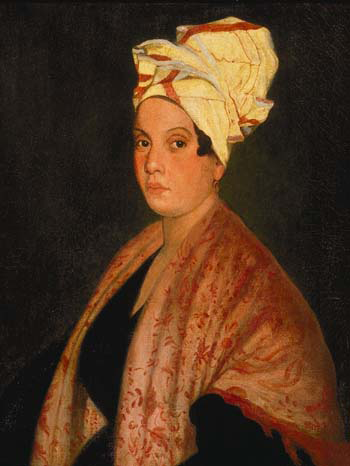
ルイジアナのヴードゥー
Louisiana Voodoo
Frank
Schneider's painting Portrait of a Creole Woman with Madras Tignon,
circa 1915, after an earlier work by George Catlin. This has been
interpreted as a possible portrayal of Voodoo priestess Marie Laveau
☆
ルイジアナ・ブードゥー教[フードゥー/ フゥードゥー Hoodoo](フランス語: Vaudou louisianais、スペイン語: ルイジアナ・クレオール語:
Voudou
Lalwizyàn)は、ニューオーリンズ・ブードゥー[フゥードゥー]としても知られ、ルイジアナ州で生まれたアフリカ系ディアスポラ宗教であり呪術的
伝統である。西ア
フリカの伝統宗教、ローマ・カトリックのキリスト教、ハイチのヴォドゥーとのシンクレティズムの過程で生まれた。ルイジアナ・ブードゥー教は、中央当局の
支配を受けず、自治グループによって組織されている。
歴史的記録には、ヴードゥー教で崇拝されていたさまざまな神々の名前が記されている。その中でも特に有名なのは、ブラン・ダニ、グランド・ゾンビ、パパ・
レバトである。これらは祭壇で崇拝され、生贄が捧げられた。死者の霊もまた、歴史的なヴードゥー教において重要な役割を果たしており、現代の修行者の中に
は、この宗教を祖先崇拝の一形態とみなす者もいる。歴史的な記述によると、19世紀
には聖人が重要な役割を果たしたが、20世紀のリバイバルの中で、他の
アフリカのディアスポラ宗教の神々を崇拝することが一般的になった。グリグリとして知られるお守りの生産も重要な役割を果たしている。
18世紀初頭から、奴隷にされた西アフリカ人(その大半はバンバラ人とコンゴ人)がフランスの植民地ルイジアナに連れてこられた。そこでは、彼らの伝統的
な宗教がフランス人のローマ・カトリックの信仰と同化していた。これはルイジアナがスペインの支配下に入り、1803年にアメリカ合衆国に買収された後も
続いた。19世紀初頭、ハイチ革命から逃れた多くの移民がルイジアナに到着し、ハイチ・ヴォドゥーを持ち込んだ。この宗教が禁止されたことはなかったが、
黒人がいつ、どこに集まるかを規制する様々な法律によって、その実践が制限された。密かに実践され、ミシシッピ川を遡ってミズーリ州まで広まった。19世
紀には、マリー・ルボーなどの修行者が大きな注目を集めた。20世紀初頭までに、ヴードゥーの公の実践は激減した。1960年代以降、ニューオーリンズの
観光産業は観光客を惹きつけるためにヴードゥー教への言及を増やす一方、ヴードゥー教の復興が起こり、その実践者たちは、ハイチのヴォドゥーやキューバの
サンテリアなど、他のアフリカ系ディアスポラ宗教を重用した。
ルイジアナ・ブードゥーはニューオーリンズのアフリカ系ディアスポラ・コミュニティに端を発するが、少なくとも19世紀以降は白人の参加者もおり、現代の
ブードゥー・グループの中には白人が大多数を占めるものもある。この宗教は長い間、非修行者からの反対に直面しており、彼らはこの宗教を魔術や悪魔崇拝と
みなしてきた(→「ハイチのヴードゥー」)。
| Louisiana Voodoo
(French: Vaudou louisianais, Spanish: Vudú de Luisiana, Louisiana
Creole: Voudou Lalwizyàn), also known as New Orleans Voodoo, is an
African diasporic religion and magic tradition that originated in
Louisiana. It arose through a process of syncretism between the
traditional religions of West Africa, the Roman Catholic form of
Christianity, and Haitian Vodou. No central authority is in control of
Louisiana Voodoo, which is organized through autonomous groups. Historical records reveal the names of various deities who were worshiped in Voodoo. Prominent among them were Blanc Dani, the Grand Zombi, and Papa Lébat. These were venerated at altars, where sacrifices were made to them. Spirits of the dead also played a prominent role in historical Voodoo, with some contemporary practitioners regarding the religion as a form of ancestor worship. Historical accounts suggest that in the 19th century, the saints played a prominent role, although amid the 20th-century revival, the veneration of deities from other African diasporic religions became common. The production of charms, which are known as gris-gris, plays an important part. From the early 18th century, enslaved West Africans—the majority of them Bambara and Kongo—were brought to the French colony of Louisiana. There, their traditional religions would have syncretized with the Roman Catholic beliefs of the French. This continued as Louisiana came under Spanish control and was then purchased by the United States in 1803. In the early 19th century, many migrants fleeing the Haitian Revolution arrived in Louisiana, bringing with them Haitian Vodou, which contributed to the formation of Louisiana Voodoo. Although the religion was never banned, its practice was restricted through a range of laws regulating when and where black people could gather. Practiced secretly, it spread up the Mississippi River to Missouri. During the 19th century, practitioners such as Marie Laveau, attracted considerable attention. By the early 20th century, the public practice of Voodoo had heavily declined. After the 1960s, the New Orleans tourist industry increasingly used references to Voodoo to attract visitors, while a Voodoo revival took place, the practitioners of which often drew heavily on other African diasporic religions such as Haitian Vodou and Cuban Santería. Although originating among African diasporic communities in New Orleans, Louisiana Voodoo has included white participants since at least the 19th century, and some contemporary Voodoo groups have a majority-white membership. The religion has long faced opposition from non-practitioners, who have characterized it as witchcraft and devil-worship, and many sensationalist portrayals of the religion have featured in popular culture. |
ルイジアナ・ブードゥー教(フランス語: Vaudou
louisianais、スペイン語: ルイジアナ・クレオール語: Voudou
Lalwizyàn)は、ニューオーリンズ・ブードゥーとしても知られ、ルイジアナ州で生まれたアフリカ系ディアスポラ宗教であり呪術的伝統である。西ア
フリカの伝統宗教、ローマ・カトリックのキリスト教、ハイチのヴォドゥーとのシンクレティズムの過程で生まれた。ルイジアナ・ブードゥー教は、中央当局の
支配を受けず、自治グループによって組織されている。 歴史的記録には、ヴードゥー教で崇拝されていたさまざまな神々の名前が記されている。その中でも特に有名なのは、ブラン・ダニ、グランド・ゾンビ、パパ・ レバトである。これらは祭壇で崇拝され、生贄が捧げられた。死者の霊もまた、歴史的なヴードゥー教において重要な役割を果たしており、現代の修行者の中に は、この宗教を祖先崇拝の一形態とみなす者もいる。歴史的な記述によると、19世紀には聖人が重要な役割を果たしたが、20世紀のリバイバルの中で、他の アフリカのディアスポラ宗教の神々を崇拝することが一般的になった。グリグリとして知られるお守りの生産も重要な役割を果たしている。 18世紀初頭から、奴隷にされた西アフリカ人(その大半はバンバラ人とコンゴ人)がフランスの植民地ルイジアナに連れてこられた。そこでは、彼らの伝統的 な宗教がフランス人のローマ・カトリックの信仰と同化していた。これはルイジアナがスペインの支配下に入り、1803年にアメリカ合衆国に買収された後も 続いた。19世紀初頭、ハイチ革命から逃れた多くの移民がルイジアナに到着し、ハイチ・ヴォドゥーを持ち込んだ。この宗教が禁止されたことはなかったが、 黒人がいつ、どこに集まるかを規制する様々な法律によって、その実践が制限された。密かに実践され、ミシシッピ川を遡ってミズーリ州まで広まった。19世 紀には、マリー・ルボーなどの修行者が大きな注目を集めた。20世紀初頭までに、ヴードゥーの公の実践は激減した。1960年代以降、ニューオーリンズの 観光産業は観光客を惹きつけるためにヴードゥー教への言及を増やす一方、ヴードゥー教の復興が起こり、その実践者たちは、ハイチのヴォドゥーやキューバの サンテリアなど、他のアフリカ系ディアスポラ宗教を重用した。 ルイジアナ・ブードゥーはニューオーリンズのアフリカ系ディアスポラ・コミュニティに端を発するが、少なくとも19世紀以降は白人の参加者もおり、現代の ブードゥー・グループの中には白人が大多数を占めるものもある。この宗教は長い間、非修行者からの反対に直面しており、彼らはこの宗教を魔術や悪魔崇拝と みなしてきた。 |
| Definitions Louisiana Voodoo was a religion,[1] one more specifically characterized as an African American religion[2] or a creole religion.[3] Louisiana Voodoo has also been referred to as New Orleans Voodoo,[4] and—in some older texts—Voodooism.[5] The scholar Ina J. Fandrich described it as the "Afro-Creole counterculture religion of southern Louisiana".[6] It was influenced heavily by the traditional African religions brought to the region, predominantly from West Central Africa and Senegambia, before later also being influenced by the Haitian Vodou.[7] The religion emerged along the Mississippi River valley, and especially in the city of New Orleans, in the 18th and early 19th century before fading out in the early 20th century.[8] The historical record for Voodoo is fragmentary,[9] with much knowledge of the religion being lost and not recoverable.[10] In the late 20th century there was a revival of Louisiana Voodoo, creating a tradition that "more closely resembles" Haitian Vodou and Cuban Santería than the 19th-century Louisiana Voodoo that is described in historical accounts.[11] Some 21st-century practitioners have also sought instruction from West African traditions, for instance, being initiated into West African Vodun.[12] Although the spelling Voodoo is now the most popular term for this tradition,[13] variant spellings have been used over the years;[14] alternatives have included Voudou and Vaudou.[15] The spelling Voodoo is sometimes used for the Louisiana practice to distinguish it from Haitian Vodou.[16] In some sources, practitioners are referred to as Voodoos themselves,[17] and elsewhere as Voodooists.[18] A related term is hoodoo, which may originally have been largely synonymous with Voodoo.[19] Over time, hoodoo came to describe "the brand of African American supernaturalism found along the Mississippi", entailing the use of charms and spells that made little reference to deities; in this it differs from the specific religion characterized by the term Voodoo.[20] Louisiana Voodoo is a secretive religion;[21] in 1972, for instance, the historian Blake Touchstone noted that Louisiana Voodoo was then largely being practiced outside the public eye.[22] Among some contemporary practitioners there is a tradition not to speak to non-adherents about Voodoo.[23] Louisiana Voodoo has not remained static, but has adapted and changed over time;[21] in its original form, it probably survived into the early 20th century.[24] Voodoo is a largely oral tradition.[25] It has no formal creed,[26] not a specific sacred text,[27] and has no unifying organized structure or hierarchy.[28] Practitioners will often adapt Voodoo to suit their specific requirements,[29] in doing so often mixing it with other religious traditions.[30] Throughout its history, many Voodoo practitioners have also practiced Roman Catholicism.[30] While in the 21st century, Voodoo practitioners have for instance combined Voodoo with elements of Judaism and the Kabbalah,[30] or with Hinduism.[31] |
定義 ルイジアナ・ブードゥーは宗教のひとつであり[1]、特にアフリカ系アメリカ人の宗教[2]またはクレオール宗教[3]として特徴づけられる。 ルイジアナ・ブードゥーはニューオーリンズ・ブードゥーとも呼ばれ[4]、古い文献ではブードゥー教とも呼ばれる。ファンドリッチはこれを「ルイジアナ州 南部のアフロ・クレオール・カウンターカルチャーの宗教」と表現した[6]。主に西中央アフリカとセネガンビアからこの地域にもたらされた伝統的なアフリ カの宗教から大きな影響を受け、後にハイチのヴォドゥーからも影響を受けるようになった[7]。 ヴードゥーの歴史的記録は断片的であり[9]、その宗教に関する多くの知識は失われ、復元不可能である。 [10]20世紀後半にはルイジアナ・ブードゥーの復活があり、歴史的記述にある19世紀のルイジアナ・ブードゥーよりもハイチのヴォドゥーやキューバの サンテリアに「より近い」伝統が作られた[11]。 現在ではVoodooという綴りがこの伝統に対する最も一般的な用語であるが[13]、長年に渡って様々な綴りが使用されており[14]、Voudouや Vaudouといった綴りもある[15]。 Voodooという綴りはハイチ・ヴォドゥと区別するためにルイジアナの修行に対して使用されることもある[16]。 [18]関連する用語としてフードゥー(hoodoo)があるが、これは元々はヴードゥーとほぼ同義語であった可能性がある[19]。時が経つにつれて、 フードゥーは「ミシシッピ川沿いで見られるアフリカ系アメリカ人の超自然主義」を表すようになり、神々への言及がほとんどないお守りや呪文の使用を伴うよ うになった。この点で、ヴードゥーという用語で特徴付けられる特定の宗教とは異なる[20]。 ルイジアナ・ブードゥーは秘密主義的な宗教であり[21]、例えば1972年に歴史家のブレイク・タッチストーンは、ルイジアナ・ブードゥーは当時、大部 分が人目に触れることなく実践されていたと指摘している[22]。現代の実践者の中には、ブードゥーについて信者以外に話さないという伝統がある [23]。 ヴードゥーは主に口承による伝統であり[25]、正式な信条はなく[26]、特定の聖典もなく[27]、統一された組織構造やヒエラルキーもない [28]。 [30]ヴードゥーの歴史を通じて、多くのヴードゥーの修行者はローマ・カトリックも信仰していた[30]が、21世紀には、ヴードゥーの修行者は、例え ばヴードゥーをユダヤ教やカバラ[30]の要素やヒンドゥー教と組み合わせている[31]。 |
| Beliefs Deities Louisiana Voodoo had no formal theology,[26] although displayed its own spiritual hierarchy.[24] Many practitioners of Voodoo have not seen their religion as being in intrinsic conflict with the Roman Catholicism that was dominant along the Mississippi River.[20] The names of Louisiana Voodoo's deities were recorded in various 19th-century sources.[32] These deities seem to derive predominantly from spirits venerated around the Bight of Benin.[33] In contrast to Haitian Vodou, there is no evidence that these were divided into groups known as nanchon (nations).[34] Tout, tout, pays blanc — Danié qui commandé Danié qui commandé ça! Danié qui commandé — A song used among Louisiana field hands, recorded in 1885, that probably related to Blanc Dani[35] One of the most important deities was Blanc Dani, also known as Daniel Blanc or Monsieur Danny.[36] The earliest records of him date from 1880,[35] and it is probable that he derives from Dan or Da, a deity venerated by the Fon and Ewe people whose worship centred largely around Ouidah.[37] In West Africa, Dan is associated with the color white and this may explain suggestions from the Louisiana material that Blanc Dani was perceived as a white man.[37] Although there are no specific references to Blanc Dani being a serpent, the prominence of snakes within Louisiana Voodoo might have been an allusion to Blanc Dani, for Dan is often associated with snakes in both West Africa and in his Haitian form, Damballa.[38] Another recorded name, Dambarra Soutons, may be an additional name for Blanc Dani.[39] A similar figure, Grandfather Rattlesnake, appeared in the 19th-century folklore of African-American Missourians and may also be a development of the same West African character.[40] It is also possible that Blanc Dani was ultimately equated with another deity, known as the Grand Zombi, whose name meant "Great God" or "Great Spirit;"[32] the term Zombi derives from the Kongo Bantu term nzambi (god).[41] Another prominent deity was Papa Lébat, also called Liba, LaBas, or Laba Limba, and he was seen as a trickster as well as a doorkeeper;[32] he is the only one of these New Orleans deities with an unequivocally Yoruba origin.[42] Monsieur Assonquer, also known as Onzancaire and On Sa Tier, was associated with good fortune, while Monsieur Agoussou or Vert Agoussou was associated with love.[32] Vériquité was a spirit associated with the causing of illness, while Monsieur d'Embarass was linked to death.[32] Charlo was a child deity.[32] The names of several other deities are recorded, but with little known about their associations, including Jean Macouloumba, who was also known as Colomba; Maman You; and Yon Sue.[32] There was also a deity called Samunga, called upon by practitioners in Missouri when they were collecting mud.[32] The Voodoo revival of the late 20th century has drawn many of its deities from Haitian Vodou, where these divinities are called lwa[43]. Among the lwa commonly venerated are Erzulie Freda Ezili la Flambo, Ogoun, Mara, and Papa Legba.[44] These can be divided into separate nanchon (nations), such as the Rada and the Petwo. Glassman's New Orleans temple for instance has separate altars to the Rada and Petwo lwa.[45] Each of these is associated with particular items, colors, numbers, foodstuff, and drinks.[46] They are often considered to be intermediaries of God, who in Haitian Vodou is usually termed Le Bon Dieu.[47] 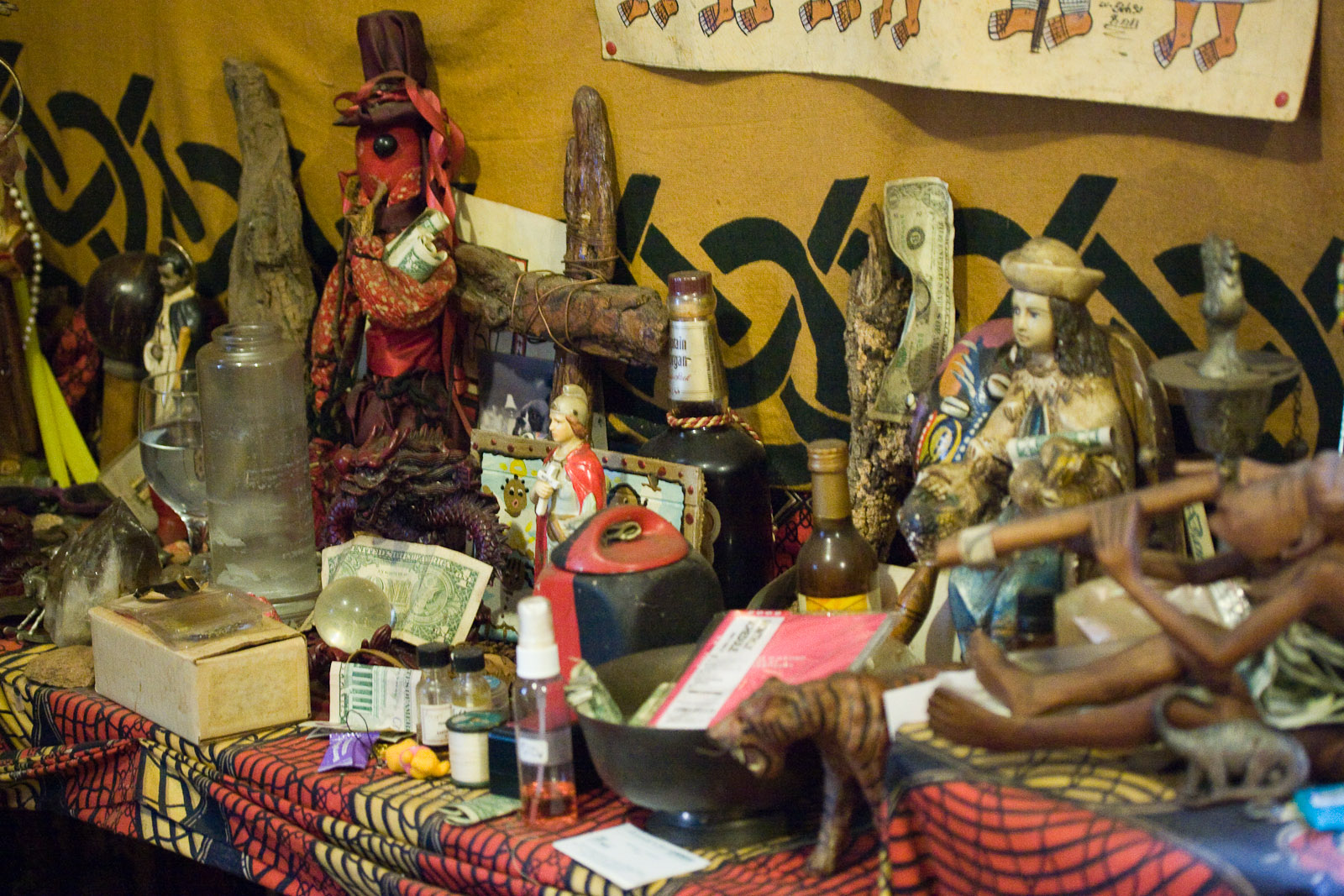 An altar used in Louisiana Voodoo, on display in the French Quarter of New Orleans 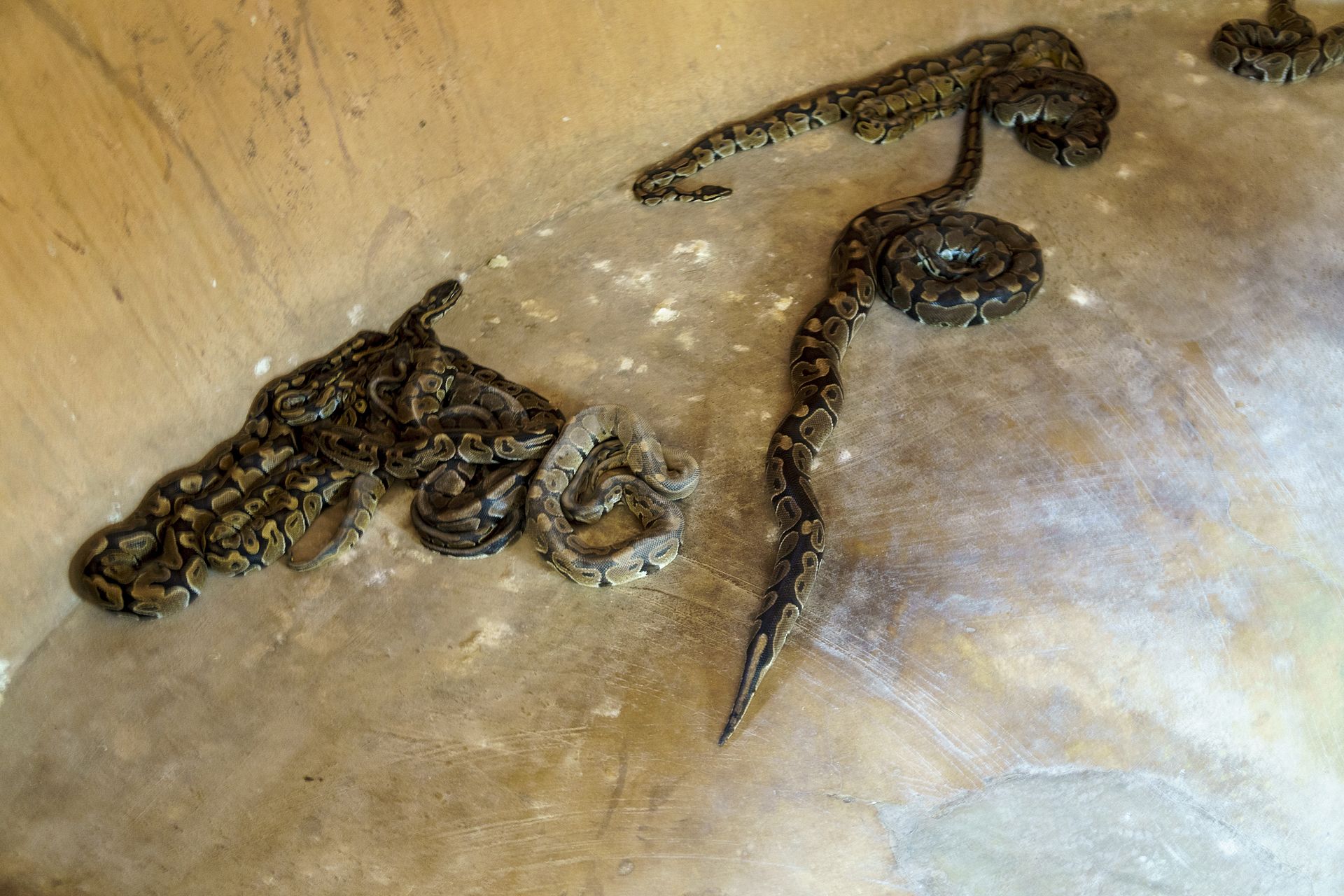 The use of live snakes in Louisiana Voodoo may relate to the West African association between snakes and the deity Dan; the latter is evident at the Temple of the Pythons in Ouidah (pictured) |
信仰 神々 ルイジアナ・ブードゥーには正式な神学はなかったが[26]、独自の精神的ヒエラルキーを示していた[24]。ブードゥーの多くの修行者は、自分たちの宗 教がミシシッピ川沿いで支配的だったローマ・カトリックと本質的に対立しているとは考えていなかった。 [20]ルイジアナ・ブードゥーの神々の名前は19世紀の様々な資料に記録されている[32]。これらの神々は主にベナン湾周辺で崇拝されていた精霊に由 来しているようである[33]。ハイチのヴォドゥーとは対照的に、これらがナショナリズム(国民)として知られるグループに分かれていたという証拠はない [34]。 すべて、すべて、青き国 - Danié qui commandé ダニエ・クワ・コマンデ・サー ダニエ・キ・コマンデ - 1885年に録音されたルイジアナの野手の間で使われていた歌で、おそらくブラン・ダニに関連している[35]。 最も重要な神々のひとりは、ダニエル・ブランまたはムッシュ・ダニーとしても知られるブラン・ダニであった[36]。ブラン・ダニに関する最も古い記録は 1880年のものであり[35]、ダンまたはダに由来している可能性が高い。 [37]ブラン・ダニが蛇であるという具体的な言及はないが、ルイジアナ・ブードゥー教における蛇の隆盛はブラン・ダニへの暗示であったかもしれない。 [同様の人物であるガラガラヘビ爺さんは、19世紀のアフリカ系アメリカ人ミズーリ人の伝承に登場し、同じ西アフリカの人物の発展形である可能性もある [40]。 また、ブラン・ダニが最終的に「偉大なる神」や「偉大なる精霊」を意味するグランド・ゾンビとして知られる別の神と同一視された可能性もある[32]。 [41]もう一人の著名な神はパパ・レバトであり、リバ、ラバス、またはラバ・リンバとも呼ばれ、彼はトリックスターであると同時にドアキーパーと見なさ れていた[32]。 ヴェリキテは病気を引き起こす精霊であり、ムッシュ・ダンヴァラスは死に関連していた[32]。 [32]他にも、コロンバとしても知られていたジャン・マクールンバ、ママン・ユー、ヨン・スーなど、いくつかの神々の名前が記録されているが、その関連 性についてはほとんど知られていない[32]。サムンガと呼ばれる神も存在し、ミズーリ州の修行者が泥を集める際に呼び出された[32]。 20世紀後半のヴードゥー教の復興は、ハイチのヴォドゥーから多くの神々を引き出しており、これらの神々はルワと呼ばれている[43]。一般的に崇拝され ているルワの中には、エルズリー・フレダ・エジリ・ラ・フランボ、オグン、マーラ、パパ・レグバがいる[44]。これらは、ラダやペツォといった別々のナ ンチョン(国民)に分けられる。例えば、グラスマンのニューオーリンズの寺院には、ラダとペツー・ルワのための別々の祭壇がある[45]。これらのそれぞ れは、特定のアイテム、色、数、食材、飲み物に関連付けられている[46]。  ニューオーリンズのフレンチ・クォーターに展示されているルイジアナ・ブードゥー教で使われる祭壇  ルイジアナのヴードゥー教における生きた蛇の使用は、西アフリカにおける蛇と神ダンとの関連と関係があるかもしれない。後者は、ウィダのニシキヘビ神殿 (写真)で明らかである。 |
Ancestors and saints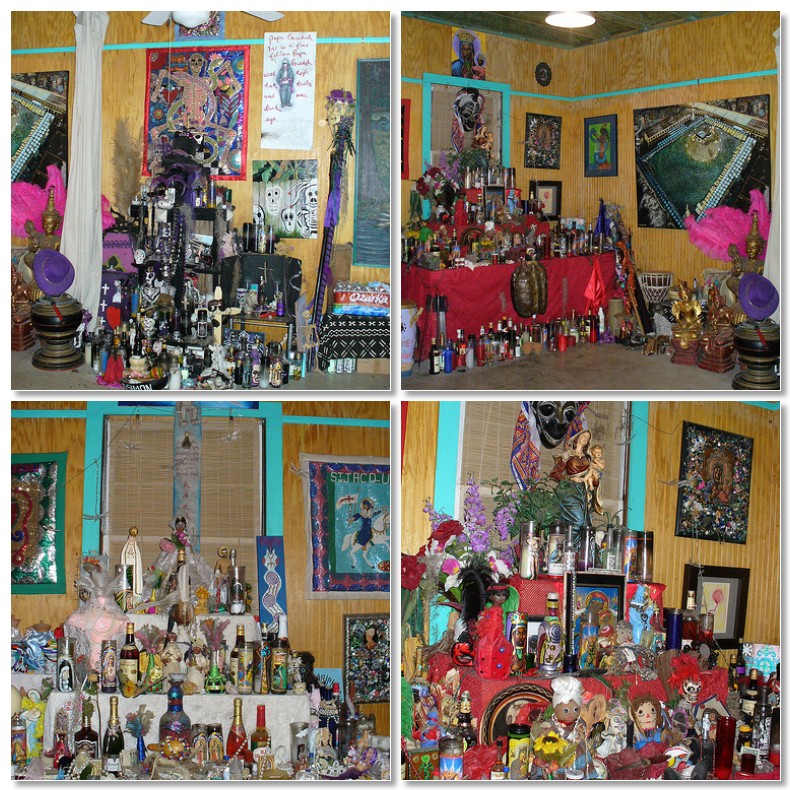 Altars constructed by Voodoo practitioner Sallie Ann Glassman in the Bywater area of New Orleans The spirits of the dead played a prominent role in Louisiana Voodoo during the 19th century.[48] The prominence of these spirits of the dead may owe something to the fact that New Orleans' African American population was heavily descended from enslaved Kongolese, whose traditional religions placed emphasis on such spirits.[41] In the 21st century, Louisiana Voodoo has been characterized as a system of ancestor worship.[49] Communicating with the ancestors is an important part of its practice,[50] with these ancestral spirits often invoked during ceremonies.[51] As Africans arrived in Louisiana, they adopted from Roman Catholicism and so various West African deities became associated with specific Roman Catholic saints.[52] Interviews with elderly New Orleanians conducted in the 1930s and 1940s suggested that, as it existed in the closing three decades of the 19th century, Voodoo primarily entailed supplications to the saints for assistance.[53] Among the most popular was Saint Anthony of Padua; this figure is also the patron saint of the Kongo, a likely link to the heavily Kongo-descended population of New Orleans.[54] Rejecting the centrality of the saints for her 21st-century practice, Osbey has described these saints as "servants and messengers of the Ancestors."[55] She related that, unlike in Haitian Vodou and Cuban Santería, the Roman Catholic saints retained their distinct identities rather than being equated with specific West African deities.[55] Writing in the 2010s, the Voodoo practitioner and poet Brenda Marie Osbey described a belief in "a somewhat distant but single deity" being part of the religion,[55] while Rory O'Neill Schmitt and Rosary Hartel O'Neill expressed the belief that contemporary Voodoo was monotheistic.[47] |
先祖と聖人 ニューオーリンズのバイウォーター地区にあるヴードゥー教の修行者サリー・アン・グラスマンが建てた祭壇 19世紀のルイジアナ・ブードゥー教では、死者の霊が重要な役割を果たした[48]。このような死者の霊の隆盛は、ニューオーリンズのアフリカ系アメリカ 人の人口が、奴隷にされたコンゴ人の子孫を多く持ち、その伝統的な宗教がこのような霊を重視していたことに起因しているのかもしれない[41]。 [21世紀において、ルイジアナ・ブードゥーは祖先崇拝のシステムとして特徴づけられている[49]。祖先とのコミュニケーションはその実践の重要な部分 であり[50]、これらの祖先の霊はしばしば儀式の間に呼び出される[51]。 1930年代と1940年代に行われたニューオリンズの高齢者へのインタビューによると、19世紀末の30年間に存在したヴードゥー教は、主に聖人に援助 を求めるものであった。 [この人物はコンゴ人の守護聖人でもあり、ニューオーリンズに多く住むコンゴ人の血を引く人々との関連が考えられる[54]。21世紀の修行において聖人 の中心性を否定するオズビーは、これらの聖人を「先祖のしもべであり使者」であると説明している。 「彼女は、ハイチのヴォドゥやキューバのサンテリアとは異なり、ローマ・カトリックの聖人たちは西アフリカの特定の神々と同一視されるのではなく、独自の アイデンティティを保持していると関連づけた[55]。 2010年代に書かれたヴードゥー教の実践者であり詩人であるブレンダ・マリー・オスビーは、「やや遠いが単一の神」がこの宗教の一部であるという信仰に ついて述べており[55]、一方ローリー・オニール・シュミットとロザリー・ハーテル・オニールは、現代のヴードゥー教は一神教であるという信念を表明し ている[47]。 |
| Morality, ethics, and gender
roles In its early 21st century form, Louisiana Voodoo accords particular respect to elders.[56] Various commentators have described Louisiana Voodoo as matriarchal because of the dominant role priestesses have played in it.[57] Osbey described the religion as being "entirely within the sphere of women, whom we call Mothers."[58] The feminist theorist Tara Green defined the term "Voodoo Feminism" to describe instances whereby African American women drew upon both Louisiana Voodoo and conjure to resist racial and gender oppression that they experienced.[59] Michelle Gordon believed that the fact that free women of color dominated Voodoo in the 19th century represented a direct threat to the ideological foundations of "white supremacy and patriarchy."[60] |
道徳、倫理、性別役割 21世紀初頭の形態では、ルイジアナ・ブードゥーは年長者に特別な敬意を払っている[56]。 様々な論者がルイジアナ・ブードゥーを母系制と表現しているのは、巫女がルイジアナ・ブードゥーの中で支配的な役割を果たしてきたからである[57]。 「58]フェミニスト理論家のタラ・グリーンは、アフリカ系アメリカ人女性が経験した人種的・ジェンダー的抑圧に抵抗するためにルイジアナ・ブードゥーと 呪術の両方を利用した事例を説明するために「ブードゥー・フェミニズム」という用語を定義した[59]。 ミシェル・ゴードンは、19世紀に有色人種の自由な女性がブードゥーを支配していたという事実は、「白人至上主義と家父長制」のイデオロギー的基盤に対す る直接的な脅威であると考えた[60]。 |
Practices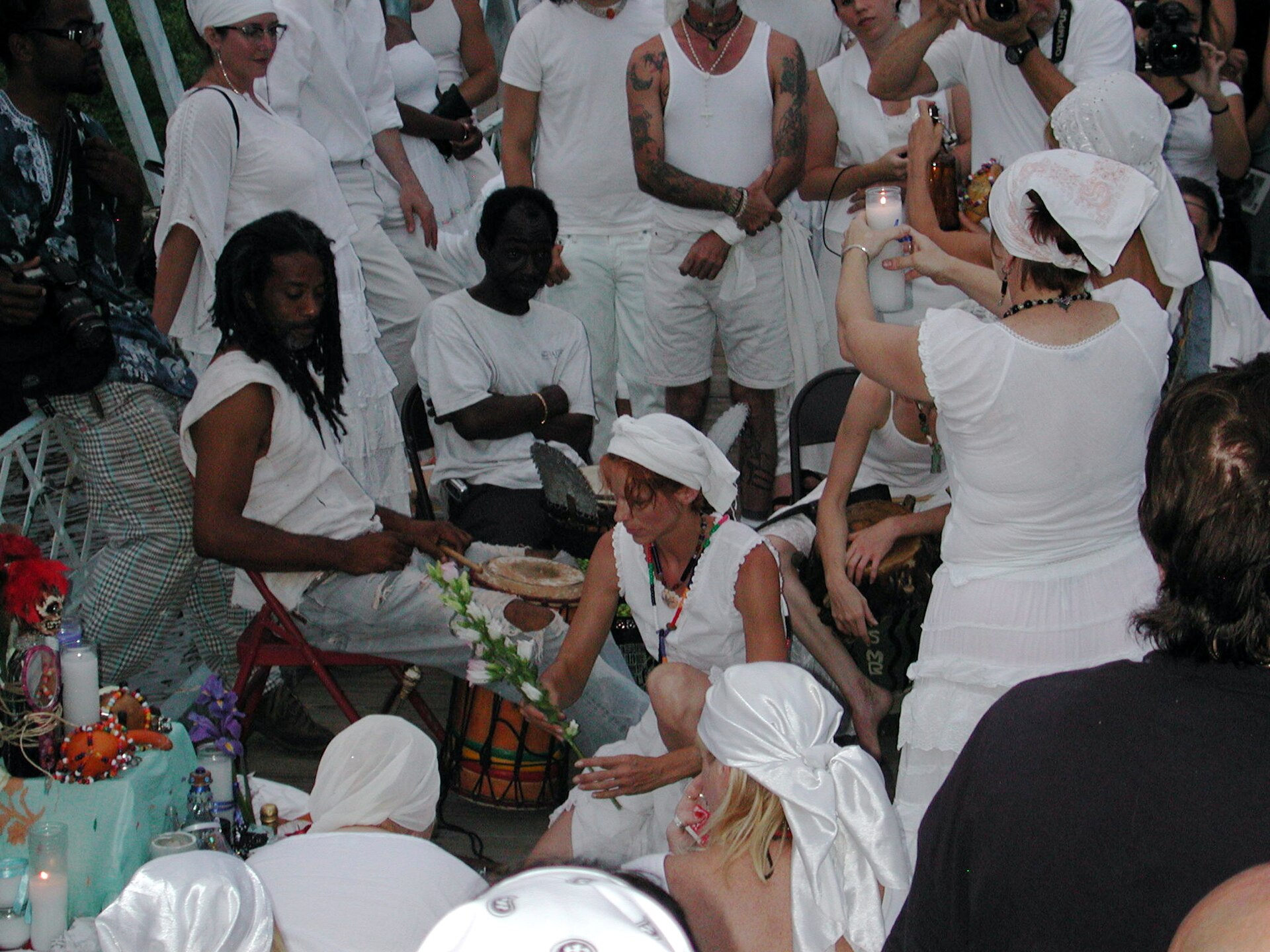 A Voodoo ritual in St. John's Bayou, New Orleans on St John's Eve 2007 There are four phases to a Voodoo ritual, all identifiable by the song being sung: preparation, invocation, possession, and farewell. The songs are used to open the gate between the deities and the human world and invite the spirits to possess someone.[61] The rituals of Louisiana Voodoo are based on African traditions that have absorbed various Christian, and especially Roman Catholic, influences.[62] Reflecting this Roman Catholic influence, some recorded ceremonies have for instance begun with the recitation of the Apostles Creed and prayers to the Virgin Mary.[62] In the 21st century, various Voodoo groups wear white clothing for their ceremonies.[63] Influenced by Haitian Vodou, those assembled may dance around a central post, the poto mitan.[64] Patterned flags, called drapos, may be brought out, while songs are sung in Haitian Kreyol.[64] Drawings, called vèvè , may be made on the floor to invoke the spirits.[65] Offerings will be given to the spirits.[66] Contemporary Voodoo rites often entail calling spirits to enter the body of a practitioner, through which they can heal or confer blessings.[67] The possessed individual will be called the "horse".[66] Practitioners sometimes performed rituals to deal with specific issues; in August 1995, Voodoo practitioners held a ritual in the Bywater area of New Orleans to try to drive away crack cocaine abuse, burglaries, prostitution, and assaults,[68] while in 2001 the Voodoo priestess Ava Kay Jones performed a rite to drive harmful spirits away from the New Orleans Saints football team in the hope of improving their performance.[11] |
プラクティス 2007年聖ヨハネの夜にニューオーリンズのセント・ジョンズ・バイユーで行われたヴードゥーの儀式 ヴードゥー教の儀式には4つの段階があり、準備、呼びかけ、憑依、別れというように、歌によって区別できる。歌は神々と人間界の間の門を開き、精霊が誰か に憑依するように誘うために使われる[61]。ルイジアナ・ブードゥーの儀式はアフリカの伝統に基づいており、キリスト教、特にローマ・カトリックの様々 な影響を吸収している[62]。このローマ・カトリックの影響を反映して、記録されている儀式の中には、例えば使徒信条の暗唱や聖母マリアへの祈りから始 まるものもある[62]。 21世紀には、様々なヴードゥー教の集団が儀式のために白い服を着ている[63]。ハイチのヴォドゥーの影響を受け、集まった人々は中央の柱であるポト・ ミタンの周りで踊ることがある[64]。ドラポスと呼ばれる模様のある旗が持ち出されることがあり、その間にハイチのクレヨールで歌が歌われる。 [64]精霊を呼び出すためにヴェヴェ(vèvè)と呼ばれる絵が床に描かれることもある[65]。 精霊に供物が捧げられる[66]。現代のヴードゥー教の儀式では、精霊を呼び出して修行者の体内に入らせることが多く、これによって精霊は治癒したり祝福 を与えたりすることができる[67]。 1995年8月には、ヴードゥー教の修行者たちがニューオーリンズのバイウォーター地区で、クラック・コカインの乱用、強盗、売春、暴行を追い払おうとす る儀式を行った[68]。2001年には、ヴードゥー教の巫女アヴァ・ケイ・ジョーンズが、ニューオーリンズ・セインツのフットボール・チームの成績向上 を願って、有害な霊を追い払う儀式を行った[11]。 |
Altars and offerings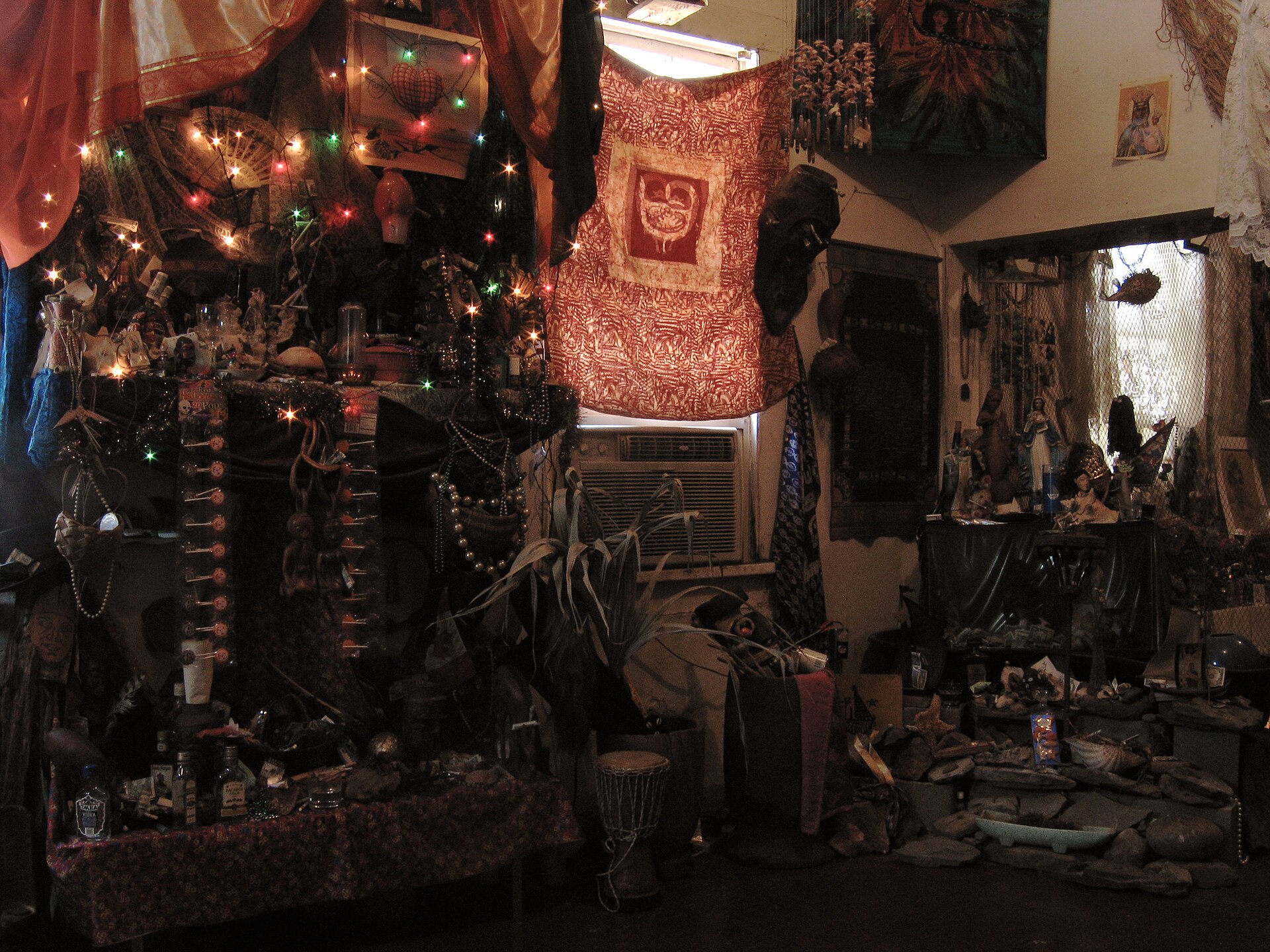 The interior of the Voodoo Spiritual Temple in New Orleans, photographed in 2005 Historical records describe the altars created by famous 19th-century Voodoo priestess Marie Laveau in her home;[69] Long noted that these descriptions resemble those of altars used in Haitian Vodou.[53] Many contemporary practitioners have their own personal altars, often located in the kitchen or living room.[70] These altars are understood as assisting communication with ancestors,[71] with food and drink being offered to the ancestors at them.[72] Sacrifice was a recurring element of Louisiana Voodoo as it was historically practiced,[73] as it continues to be in Haitian Vodou.[74] Some 21st-century practitioners of Louisiana Voodoo do sacrifice animals in their rites, subsequently cooking and eating the carcass.[74] It is nevertheless not a universal practice in Louisiana Voodoo;[74] Glassman's group prohibits animal sacrifice in its rites.[75] Although there is little proof that human sacrifice took place in Louisiana Voodoo, persistent rumors claimed that white children were being abducted and killed during some of its rites.[76] Plates of food may be left out, encircled in a ring of coins.[77] Libations may be poured.[78] Laveau used to hold weekly services, which were called parterres.[53] Music is often a part of rituals in Louisiana Voodoo.[79] Many historical Voodoo rituals involved the presence of a snake;[80] Marie Laveau was for instance described as communing with a snake during her ceremonies.[50] This practice largely died out by the end of the 19th century, although some Voodoo revivalists have incorporated snake dances into their practices.[81] In the 21st century, the New Orleans Voodoo Spiritual Temple has had its own "temple snake."[82] |
祭壇と供物 2005年に撮影されたニューオーリンズのヴードゥー・スピリチュアル・テンプルの内部 歴史的な記録には、19世紀の有名なヴードゥー教の巫女マリー・ルボーが自宅に作った祭壇についての記述がある[69]。ロングによれば、これらの記述は ハイチのヴォドゥーで使われる祭壇のものと似ている[53]。 現代の修行者の多くは、しばしば台所や居間に自分専用の祭壇を持っている[70]。これらの祭壇は祖先とのコミュニケーションを助けるものとして理解され ており[71]、祭壇では祖先に食べ物や飲み物が供えられる[72]。 生け贄はルイジアナ・ブードゥーが歴史的に実践してきた中で繰り返し行われてきた要素であり[73]、ハイチのヴォドゥーでもそれは続いている[74]。 21世紀のルイジアナ・ブードゥーの実践者の中には、儀式の中で動物を生け贄に捧げ、その後その死骸を調理して食べる者もいる[74]。 [74]それでもルイジアナ・ブードゥーでは普遍的な慣習ではなく、[74]グラスマンのグループは儀式で動物を生贄に捧げることを禁じている[75]。 ルイジアナ・ブードゥーで人間の生贄が行われていたという証拠はほとんどないが、一部の儀式で白人の子供が誘拐されて殺されていたという根強い噂がある [76]。 コインの輪に囲まれた食べ物の皿が放置されることもあり[77]、酒が注がれることもある[78]。 ルイジアナ・ブードゥー教では音楽が儀式の一部となることが多い[79]。 多くの歴史的なヴードゥー教の儀式には蛇が関与しており、[80]マリー・ルヴォーは儀式の際に蛇と交信していたと記述されている[50]。 この習慣は19世紀末までにほぼ廃れたが、一部のヴードゥー教リバイバリストは蛇の踊りを修行に取り入れている[81]。 21世紀には、ニューオーリンズ・ヴードゥー霊廟が独自の「神殿の蛇」を所有している[82]。 |
Gris-Gris and healing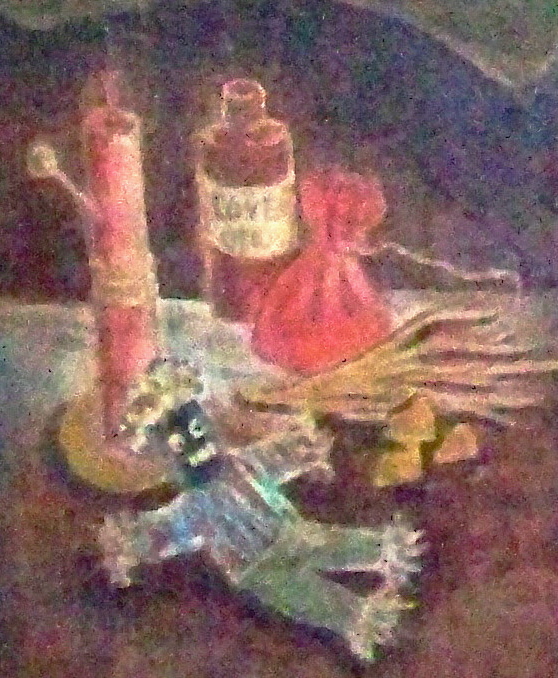 Gris-gris by Charles Gandolfo Charms, created to either harm or help, are called gris-gris.[83] This term derives from West Africa, where related words are widespread among many ethnic and linguistic groups.[84] In the Mississippi River Valley, references to gris-gris first date from the 1750s.[84] The term Zinzin, sometimes referring to positive charms, derives from the Bamana language.[85] Another term, Wanga, was more commonly used for harmful charms in Voodoo and probably derives from West Central Africa, where the terms oganga and nganga were used for priests in Kikongo.[85] A common charm for protection or luck would consist of material wrapped up in red flannel and worn around the neck.[86] Touchstone believed that gris-gris that caused actual harm did so either through the power of suggestion or by the fact that they contained poisons to which the victim was exposed.[86] One example of a Voodoo curse was to place an object inside the pillow of the victim.[87] Another involves placing a coffin (sometimes a small model; sometimes much larger) inscribed with the victim's name on their doorstep.[88] In other instances, Voodoo practitioners sought to hex others by placing black crosses, salt, or mixtures incorporating mustard, lizards, bones, oil, and grave dust on a victim's doorstep.[86] To counter these hexes, some people cleaned their doorstep or sprinkled it with powdered brick.[86] Despite its name, the idea of the Voodoo doll has little to do with either Louisiana Voodoo or Haitian Vodou; it derives from the European tradition of poppets.[89] It is possible that the act of inserting pins into a human-shaped doll to cause harm was erroneously linked to African-derived traditions due to a misunderstanding of the nkisi nkondi of Bakongo religion.[90] Healing plays a prominent role in 21st century Louisiana Voodoo.[91] Various shops, called botanicas, exist in New Orleans to sell herbs and other material for use in these preparations.[92] Glassman has produced her own New Orleans Voodoo Tarot, a tarot card set for use in divination.[93] |
グリグリとヒーリング チャールズ・ガンドルフォによるグリグリ この用語は西アフリカに由来し、多くの民族や言語集団の間で関連語が広まっている[84]。ミシシッピ川流域では、1750年代からグリグリへの言及が始 まっている[84]。ジンジンという用語は、ポジティブなお守りを指すこともあり、バマナ語に由来する[85]。 [85]もう一つの用語であるワンガは、ブードゥー教において有害なお守りに対してより一般的に使用され、おそらく西中央アフリカに由来し、キコンゴ語で 司祭に対してオガンガ(oganga)とンガンガ(nganga)という用語が使用されていた[85]。保護や幸運のための一般的なお守りは、赤いフラン ネルに包まれた材料から成り、首に巻かれていた[86]。 タッチストーンは、実害をもたらすグリグリは暗示の力か、被害者がさらされる毒を含んでいることによってそうなると信じていた[86]。 [87]別の例では、被害者の名前を刻んだ棺(小さな模型のこともあれば、かなり大きなものもある)を玄関先に置くことがある[88]。他の例では、ヴー ドゥー教の修行者たちは、黒い十字架、塩、またはマスタード、トカゲ、骨、油、墓の粉を混ぜたものを被害者の玄関先に置くことによって、他人を呪おうとし た。 [86]こうした呪いに対抗するために、玄関先を掃除したり、粉末状のレンガを振りかけたりする人々もいた[86]。その名前にもかかわらず、ヴードゥー 人形のアイデアはルイジアナ・ヴードゥーともハイチのヴォドゥーともほとんど関係がなく、ヨーロッパのポペットの伝統に由来する[89]。害を与えるため に人型の人形にピンを刺すという行為が、バコンゴ宗教のンクシ・ンクンディに対する誤解のために誤ってアフリカ由来の伝統と結びつけられた可能性がある [90]。 21世紀のルイジアナ・ブードゥー教ではヒーリングが重要な役割を果たしている[91]。ニューオーリンズにはボタニカと呼ばれる様々な店が存在し、これ らの調合に使用するハーブやその他の材料を販売している[92]。 グラスマンは占い用のタロットカードセットであるニューオリンズ・ブードゥー・タロットを制作している[93]。 |
| Animal sacrifice Animal sacrifice is now a concealed practice in Hoodoo in African-American communities because spiritual merchants and others appropriated the tradition and changed and replaced practices.[94] Animal sacrifice is a traditional practice in Africa. It is done as an offering to the spirits, and also to ask a spirit to provide protection, healing, and other requests. When Africans were enslaved in the United States the practice continued in Voodoo and Hoodoo. The animals that are sacrificed are chickens. In West Africa among the Yoruba, blood sacrifices are left for Eshu-Elegba at the crossroads. The crossroads is a spiritual door way to the spiritual realm where Eshu-Elegba resides. This practice was brought to the United States during the transatlantic slave trade, and African Americans into the twentieth century performed animal blood sacrifices at the crossroads. Eshu-Elegba became the crossroads spirit or the man of the crossroads in Voodoo.[95][96][97] Animal sacrifice has become a rare practice in the African American community. However, animal sacrifice was documented well into the late nineteenth century and into mid-twentieth century.[98] For example, animal sacrifices are sometimes done at the crossroads as an offering to the crossroad spirit and to ask the spirit or spirits for a request. At Stagville Plantation located in Durham County, North Carolina, enslaved Africans performed animal sacrifice to call forth spirits for assistance in the slave community.[99] At the Kingsley Plantation at Fort George Island, Florida, archeologists found evidence of West African animal sacrifice inside a slave cabin. West-Central African people were illegally imported into Florida after 1814 by plantation owner Kingsley. The African people imported were Angolan, Igbo, Senegambian and from Zanzibar. The spiritual cultures of these enslaved Africans fused into one Voodoo culture on the plantation. Archeologists found inside a slave cabin in the northeast section an intact sacrificed chicken and other charms (blue beads and red clay brick) for rituals to conjure spirits for protection.[100] In 1883 in Alabama, a rootworker sacrificed a chicken to leave a blood offering to the spirits to remove a spiritual work (spell).[101] An African American man in North Carolina sacrificed a chicken at a crossroads "asking salvation from an epidemic" from a disease that killed off his farm animals.[102][103] Zora Neale Hurston recorded in her book Mules and Men an animal sacrifice of nine black chickens in the twentieth century. A Hoodoo man named Turner in New Orleans, Louisiana performed an animal sacrifice for a client who wanted her brother in-law to leave her alone. Turner sat at his snake altar and meditated on his clients situation, and afterwards told Hurston to purchase nine black chickens and some Four Thieves Vinegar. Turner and Hurston performed a ritual including the nine black chickens and Four Thieves Vinegar at night to ask the spirits and the spirits of the chickens sacrificed for his clients brother in-law to stop bothering her. The ritual included Turner dancing in a circle swirling the chickens in his hand, and killed them by taking off their heads, and Hurston continued to beat the ground with a stick in order to produce a rhythmic sound in sync with Turner's dancing. Where the ritual took place Four Thieves Vinegar was poured onto the ground.[104] In some African American Spiritual churches, the sacrifice of live chickens to heal church members was practiced in a Spiritual church in New Orleans by Mother Catherine Seals in the early to mid-twentieth century.[105] |
動物の生け贄 アフリカ系アメリカ人のコミュニティにおけるフードゥーでは、スピリチュアル商人などが伝統を流用し、慣習を変更したり置き換えたりしたため、動物の生け 贄は現在では隠された慣習となっている[94]。 動物の生け贄はアフリカの伝統的な慣習である。精霊への供え物として、また精霊に保護や癒し、その他の依頼をするために行われる。アフリカ人が米国で奴隷 になった後も、ヴードゥー教やフードゥー教ではこの習慣が続いていた。生贄となる動物は鶏である。西アフリカのヨルバ族では、十字路のエシュ=エレグバに 血の犠牲を捧げる。十字路は、エシュ=エレグバが住む霊界への霊的な出入り口である。この習慣は大西洋を横断する奴隷貿易の間にアメリカに持ち込まれ、 20世紀に入ってアフリカ系アメリカ人は十字路で動物の血の生け贄を捧げた。エシュ=エレグバはヴードゥー教における十字路の精霊または十字路の男となっ た[95][96][97]。動物の生け贄はアフリカ系アメリカ人のコミュニティでは珍しい習慣となった。しかし、動物の生け贄は19世紀後半から20世 紀半ばにかけても記録されている[98]。例えば、動物の生け贄は岐路の精霊への供え物として、また精霊や精霊にお願いをするために岐路で行われることが ある。ノースカロライナ州ダラム郡にあるスタッグヴィル・プランテーションでは、奴隷にされたアフリカ人たちが、奴隷社会での援助のために精霊を呼び出す ために動物の生け贄を行っていた[99]。 フロリダ州フォート・ジョージ・アイランドにあるキングスレー・プランテーションでは、考古学者が奴隷小屋の中で西アフリカ人が動物の生け贄を行っていた 証拠を発見した。西中央アフリカの人々は、1814年以降、農園主のキングスレーによってフロリダに不法輸入された。輸入されたアフリカ人はアンゴラ人、 イボ人、セネガンビア人、ザンジバル人であった。プランテーションでは、奴隷にされたアフリカ人たちの精神文化が融合し、ひとつのヴードゥー教文化が形成 された。考古学者が北東部の奴隷小屋の中で発見したのは、生け贄に捧げられた無傷の鶏と、保護のために精霊を呼び出す儀式のための他のお守り(青いビーズ と赤い粘土レンガ)であった[100]。 1883年にアラバマ州で、根仕事人が霊的な仕事(呪文)を取り除くために、精霊に血を捧げるために鶏を生け贄に捧げた。 [101] ノースカロライナ州のアフリカ系アメリカ人の男性は、自分の農場の家畜を死に至らしめた病気から「伝染病からの救いを求めて」十字路でニワトリを生け贄に 捧げた[102][103] ゾラ・ニール・ハーストンは彼女の著書『Mules and Men』の中で、20世紀に9羽の黒人のニワトリを生け贄に捧げたことを記録している。ルイジアナ州ニューオーリンズのターナーというフードゥー教の男 は、義理の兄に放っておいてほしいという客のために動物の生け贄を捧げた。ターナーは蛇の祭壇に座り、依頼人の状況について瞑想した後、ハーストンに9羽 の黒い鶏と四泥棒の酢を買うように言った。ターナーとハーストンは夜、9羽の黒い鶏と四泥棒酢を使った儀式を行い、依頼人の義理の弟のために生け贄に捧げ た鶏の霊と精霊に、彼女を煩わせないようお願いした。儀式には、ターナーが手にした鶏を振り回しながら輪になって踊り、首を切り落として殺すというものも 含まれており、ハーストンはターナーの踊りに合わせてリズミカルな音を出すために棒で地面を叩き続けた。儀式が行われた場所では、地面に四つの泥棒酢がか けられた[104]。アフリカ系アメリカ人のスピリチュアルな教会では、教会員を癒すために生きた鶏を生贄に捧げることが、20世紀初頭から半ばにかけて マザー・キャサリン・シールズによってニューオーリンズのスピリチュアルな教会で行われていた[105]。 |
| Communal festivals Communal festivals were also part of Mississippi River Voodoo.[85] A common gathering in Louisiana Voodoo was on the night of the 23 or 24 June, St John's Eve,[106] with big celebrations on this date has taken place on the shores of Lake Pontchartrain during the 19th century.[53] Some 21st-century Voodoo congregations continue to celebrate on St John's Eve;[107] others, such as Osbey, reject the idea that St John's Eve is important in Louisiana Voodoo.[108] Various contemporary practitioners celebrate All Saints Day (1 November) which they, following Haitian Vodou, link with the lwa Gede.[109] |
共同体の祭り ルイジアナ・ブードゥーにおける一般的な集会は6月23日または24日の夜、聖ヨハネのイヴであり[106]、19世紀にはこの日にポンチャートレイン湖 畔で大規模な祝祭が行われていた[53]。 [53]21世紀のヴードゥー教の信徒の中には、聖ヨハネ・イヴに祝祭を続けている者もいる[107]が、オズビーのように、聖ヨハネ・イヴがルイジア ナ・ヴードゥー教において重要であるという考えを否定する者もいる[108]。 現代の様々な修行者たちは、ハイチ・ヴォドゥーに倣って、ルワ・ゲデと結びつける万聖節(11月1日)を祝っている[109]。 |
| History French and Spanish Louisiana Much mystery surrounds the origins of Louisiana Voodoo,[14] with its history often being embellished with legend.[110] French settlers arrived in Louisiana in 1699, with the first enslaved Africans being brought to the colony in 1719.[111] In 1763 the Spanish Empire took control and remained in power until 1803.[111] The religions of the West African slaves combined with elements of the folk Catholicism practiced by the dominant French and Spanish colonists to provide the origins of Louisiana Voodoo.[112] Under the French and Spanish colonial governments, Voodoo did not experience strong persecution; there are no records of the Roman Catholic Church waging "anti-superstition campaigns" against the religion in Louisiana.[112] All of the West African groups contributed to the development of Louisiana Voodoo. Their knowledge of herbs, poisons, and the ritual creation of charms and amulets, intended to protect oneself or harm others, became key elements of Louisiana Voodoo.[113] During the French colonial period, around 80 percent of the enslaved Africans brought to Louisiana were from the Bambara people of the Senegal River basin.[41] Most of the other 20 percent were Kongolese, with a few from Dahomey.[41] After the Spanish took control, increasing numbers of slaves were imported from the Kongo, ensuring a "Kongolization of New Orleans's African American community".[41] The enslaved community quickly outnumbered white European colonists who emigrated there. The French colony was not a stable society when the enslaved sub-Saharan Africans arrived, and the newly arrived sub-Saharan Africans dominated the slave community. According to a census of 1731–1732, the ratio of enslaved sub-Saharan Africans to European settlers was more than two to one.[114] A relatively small number of colonists were planters and slaveholders, owners of sugar plantations with work that required large labor forces. Because the Africans were held in large groups relatively isolated from interaction with whites, their preservation of African indigenous practices and culture was enabled.[115] In northern Louisiana and other European colonies in the American South, enslaved families were usually divided; large numbers of African slaves who were once closely related by family or community were sent to different plantations. However, in southern Louisiana, families, cultures, and languages were kept more intact than in the north. This allowed the cultural traditions, languages, and religious practices of the enslaved to continue there.[116] Under the French code and the influence of Catholicism, officials nominally recognized family groups, prohibiting the sale of slave children away from their families if younger than age fourteen. They promoted the man-made legend of wake tuko[clarification needed] of the enslaved population.[117] The high mortality of the slave trade brought its survivors together with a sense of solidarity and initiation. The absence of fragmentation in the enslaved community, along with the kinship system produced by the bond created by the difficulties of slavery, resulted in a "coherent, functional, well-integrated, autonomous, and self-confident enslaved community."[118] The practice of making and wearing charms and amulets for protection, healing, or the harm of others was a key aspect to early Louisiana Voodoo.[119] The Ouanga, a charm used to poison an enemy, contained the toxic roots of the figuier maudit tree, brought from Africa and preserved in Louisiana. The ground-up root was combined with other elements, such as bones, nails, roots, holy water, holy candles, holy incense, holy bread, or crucifixes. The administrator of the ritual frequently evoked protection from Jehovah and Jesus Christ. This openness of African belief allowed for the adoption of Catholic practices into Louisiana Voodoo.[120] Another element brought from West Africa was the veneration of ancestors and the subsequent emphasis on respect for elders. For this reason, the rate of survival among elderly enslaved peoples was high, further "Africanizing Louisiana Creole culture."[121] Records of African traditional religious practices being practiced in Louisiana go back to the 1730s, when Antoine-Simon Le Page du Pratz wrote about the use of gris-gris.[122] |
歴史 フランスとスペインのルイジアナ ルイジアナ・ブードゥーの起源は多くの謎に包まれており[14]、その歴史はしばしば伝説で飾られている[110]。 1699年にフランス人入植者がルイジアナに到着し、1719年に最初のアフリカ人奴隷が植民地に連れて来られた[111]。 [111]西アフリカの奴隷の宗教は、支配的なフランスとスペインの植民者によって実践された民間カトリックの要素と組み合わされ、ルイジアナ・ブー ドゥーの起源となった[112]。フランスとスペインの植民地政府の下で、ブードゥーは強い迫害を経験しなかった。 ルイジアナ・ブードゥーの発展には、西アフリカのすべてのグループが貢献した。彼らの薬草や毒の知識、身を守ったり他者に害を与えたりするためのお守りや 魔除けの儀式はルイジアナ・ブードゥーの重要な要素となった[113]。 [41]残りの20パーセントのほとんどはコンゴ人であり、ダホメイの出身者も少数いた[41]。スペインが支配権を握った後、コンゴから輸入される奴隷 の数が増え、「ニューオーリンズのアフリカ系アメリカ人コミュニティのコンゴ人化」が確実になった[41]。 奴隷化されたコミュニティは、移住してきたヨーロッパ系白人入植者の数をすぐに上回った。奴隷にされたサハラ以南のアフリカ人が到着したとき、フランスの 植民地は安定した社会ではなく、新しく到着したサハラ以南のアフリカ人が奴隷社会を支配していた。1731年から1732年の国勢調査によれば、奴隷にさ れたサハラ以南のアフリカ人とヨーロッパ人入植者の比率は2対1以上であった[114]。比較的少数の入植者は、大規模な労働力を必要とする仕事を持つ砂 糖プランテーションの所有者であるプランターや奴隷所有者であった。アフリカ人は白人との交流から比較的隔離された大規模な集団に収容されていたため、ア フリカ固有の慣習や文化の保存が可能であった[115]。ルイジアナ北部やアメリカ南部の他のヨーロッパ植民地では、奴隷化された家族は通常分割されてお り、かつて家族やコミュニティで密接な関係にあった多数のアフリカ人奴隷が別々のプランテーションに送られた。しかし、ルイジアナ南部では、北部よりも家 族、文化、言語が維持されていた。そのため、奴隷の文化的伝統、言語、宗教的慣習がそこで継続することができた[116]。 フランスの法典とカトリックの影響の下で、役人は名目上家族集団を認め、14歳未満の奴隷の子供を家族から引き離して売ることを禁止した。彼らは奴隷にさ れた人々のウェイク・トゥコ[要出典]という人為的な伝説を広めた[117]。奴隷貿易の高い死亡率は、その生存者たちを連帯感とイニシエーションによっ て一つにした。奴隷社会における分断の不在は、奴隷の困難によって生み出された絆によって生み出された親族制度とともに、「首尾一貫した、機能的で、よく 統合された、自律的で、自信に満ちた奴隷社会」[118]をもたらした。 護符やお守りを作ったり身につけたりする習慣は、初期のルイジアナ・ブードゥー教にとって重要な側面であった。粉砕された根は、骨、釘、根、聖水、聖なる 蝋燭、聖なる香、聖なるパン、あるいは十字架といった他の要素と組み合わされた。儀式の管理者は、しばしばエホバやイエス・キリストからの保護を呼び起こ した。このようなアフリカの信仰の開放性によって、ルイジアナ・ブードゥーにカトリックの慣習を取り入れることができた[120]。 西アフリカからもたらされたもう一つの要素は、先祖崇拝とそれに続く年長者への尊敬の強調であった。このため、奴隷にされた高齢者の生存率は高く、「ルイ ジアナ・クレオール文化をアフリカ化」[121]させた。ルイジアナでアフリカの伝統的な宗教的慣習が行われていたという記録は、アントワーヌ=シモン・ ル・パージュ・デュ・プラッツがグリ・グリの使用について記した1730年代に遡る[122]。 |
| 19th Century In 1803, the United States took control of Louisiana through the Louisiana Purchase.[123] This resulted in a large influx of Anglo-Americans into the region.[85] These Anglo-Americans often had some familiarity with African-derived traditions, such as the John Canoe festivities on the Atlantic coast and the Pinkster celebrations in New York, but were unaccustomed to a fully developed African-derived religion with its own deities and priests. They thus often regarded Voodoo as an exotic and primitive superstition.[106] The Anglo-American influx also brought new influences to Voodoo as well as increased attention, including a surge in 19th and early 20th-century newspaper coverage.[106] The start of the 19th centuries also saw the Haitian Revolution, whereby African-descended populations in the French Caribbean colony of Saint-Domingue overthrew the French colonial government and established an independent republic, Haiti.[124] As a result of the upheaval, between 15,000 and 20,000 Francophone migrants from Saint-Domingue arrived in the Mississippi River Valley as a result of the Revolution, including those of African, European, and mixed descent.[125] Many would have been familiar with Haitian Vodou and their arrival in continental North America likely reinforced and influenced Louisiana Voodoo.[126] According to legend, the first meeting place of the Voodoo practitioners in New Orleans was at an abandoned brickyard in Dumaine Street. Those meetings here faced police disruption and so future meetings took place largely in Bayou St. John and along the shores of Lake Pontchartrain.[127] The religion probably appealed to members of the African diaspora, whether enslaved or free, who lacked recourse to retribution for the poor treatment they received through other means.[128] Voodoo probably spread out from Louisiana and into African American communities throughout the Mississippi River Valley, as there are 19th-century references to Voodoo rituals in both St. Louis and St. Joseph in Missouri.[24] Voodoo was never explicitly banned in Louisiana.[124] However, amid establishment fears that Voodoo may be used to foment a slave rebellion, in 1817 the Municipal issued an ordinance preventing slaves from dancing on days other than on Sundays and in locations other than those specifically designated for that purpose. The main location permitted was New Orleans' Congo Square.[129] Voodoo dance rituals nevertheless continued clandestinely at other locations.[5] In the early part of the 19th century, newspapers articles began denouncing the religion.[124] In August 1850, about fifty women, several of whom were white, were arrested at a Voodoo dance ceremony; they were subsequently fined.[130] In 1855 a mob attempted to seize a practitioner, Elizabeth Sutherland, who they accused of putting spells on people; the local police gave her shelter at the station.[131] During the American Civil War, the Union Army occupied New Orleans and sought to suppress Voodoo.[128] In 1863, forty women were arrested at a Voodoo dance ceremony in Marais Street.[132] Repression of Voodoo intensified following the Civil War;[133] the 1870s onward saw white writers display an increased concern that Voodoo rituals were facilitating the interaction between black men and white women.[134] That decade saw large gatherings at Lake Pontchartrain on St John's Eve, including many onlookers and reporters;[135] these declined after 1876.[136] In the 1880s and 1890s, the New Orleans authorities again clamped down on Voodoo.[136] Voodoo was used as evidence to bolster the white elite's claim that Africans were inferior to Europeans and thus bolster their belief in the necessity of legalized segregation.[137] Various practitioners set up shops selling paraphernalia and charms,[138] they also began exploiting the commercial opportunities of the religion by staging ceremonies which charged entry.[133] |
19世紀 1803年、アメリカはルイジアナ購入によってルイジアナを支配下に置いた[123]。 この結果、この地域に英米人が大量に流入することになった[85]。これらの英米人は、大西洋岸のジョン・カヌー祭りやニューヨークのピンクスター祭りの ようなアフリカ由来の伝統には慣れ親しんでいたものの、独自の神々や司祭を擁する完全に発達したアフリカ由来の宗教には慣れていなかった。そのため、彼ら はしばしばヴードゥーをエキゾチックで原始的な迷信とみなしていた[106]。英米人の流入はまた、ヴードゥーに新たな影響をもたらしただけでなく、19 世紀から20世紀初頭にかけての新聞報道の急増など、注目の高まりももたらした[106]。 19世紀初頭にはハイチ革命が勃発し、カリブ海のフランス植民地であったサン・ドマングのアフリカ系住民がフランスの植民地政府を打倒し、独立共和国ハイ チを樹立した[124]。 [124] この革命の結果、サン=ドマングから15,000人から20,000人のフランス語圏の移民がミシシッピ川流域に到着した。 伝説によると、ニューオリンズでヴードゥー教の修行者たちが最初に集会を開いた場所は、デュメイン通りにある廃墟となったレンガ造りの工場であった。ここ での集会は警察の妨害に直面したため、その後の集会は主にセント・ジョン湾とポンチャートレイン湖の湖畔で行われた[127]。この宗教はおそらく、奴隷 か自由人かにかかわらず、他の手段で受けた劣悪な待遇に対する報復手段を持たないアフリカ系ディアスポラのメンバーにアピールしたのであろう。 [128] 19世紀にはミズーリ州のセントルイスとセントジョセフの両方でブードゥー教の儀式に関する記述があることから、ブードゥー教はルイジアナ州からミシシッ ピ川流域のアフリカ系アメリカ人のコミュニティへと広がっていったと考えられる[24]。 ルイジアナ州ではブードゥー教が明確に禁止されたことはなかった[124]。 しかし、ブードゥー教が奴隷の反乱を煽るために利用されるのではないかという不安の中、1817年に市は奴隷が日曜日以外の日に、その目的のために特別に 指定された場所以外で踊ることを禁止する条例を発布した。それにもかかわらず、ブードゥー教の踊りの儀式は他の場所でも密かに続けられていた[5]。 [124] 1850年8月、約50人の女性(そのうちの数人は白人)がヴードゥー教のダンス儀式で逮捕された。 南北戦争中、北軍はニューオーリンズを占領し、ヴードゥーを弾圧しようとした[128]。1863年、マレ通りで行われたヴードゥー・ダンスの儀式で40 人の女性が逮捕された[132]。南北戦争後、ヴードゥーの弾圧は強化された[133]。1870年代以降、白人の作家たちは、ヴードゥーの儀式が黒人男 性と白人女性の交流を促進しているという懸念を示した。 [134]その10年間には、多くの野次馬や記者を含む大規模な集会がセント・ジョンズ・イヴにポンチャートレイン湖で開催されたが[135]、これらは 1876年以降減少した[136]。 1880年代と1890年代には、ニューオーリンズ当局は再びヴードゥーを取り締まった[136]。ヴードゥーは、アフリカ人はヨーロッパ人より劣ってい るという白人エリートの主張を補強するための証拠として使用され、その結果、合法化された隔離の必要性に対する彼らの信念を補強した[137]。 様々な修行者たちが道具やお守りを売る店を構え[138]、入場を許可する儀式を行うことでこの宗教の商業的機会を利用し始めた[133]。 |
Prominent figures One of the most prominent figures in 19th-century Voodoo was Marie Laveau (left), whose alleged tomb remains a visitor attraction (right)  Free women of color dominated the leadership of Voodoo in New Orleans during the 19th century.[60] They made a living through the selling and administering of amulets, or "gris-gris" charms, and magical powers, as well as spells and charms that guaranteed to "cure ailments, grant desires, and confound or destroy one's enemies".[139] As in other French colonial communities, a class of free people of color developed who were given specific rights and, in New Orleans, acquired property and education. Free women of color had a relatively high amount of influence, particularly those who were spiritual leaders.[139] Among the fifteen "voodoo queens" in neighborhoods scattered around 19th-century New Orleans, Marie Laveau was known as "the Voodoo Queen", the most eminent and powerful of them all. Her religious rite on the shore of Lake Pontchartrain on St. John's Eve in 1874 attracted some 12,000 black and white New Orleanians.[140] Although her help seemed non-discriminatory, she may have favored enslaved servants: Her most "influential, affluent customers...runaway slaves...credited their successful escapes to Laveau's powerful charms".[140] Both her mother and grandmother had practiced Voodoo;[141] she was also baptized a Roman Catholic and attended mass throughout her life.[142] Laveau worked as a hairdresser, but also assisted others with the preparation of herbal remedies and charms.[18] She died in 1881.[143] Her influence continues in the city. In the 21st century, her gravesite in the oldest cemetery is a major tourist attraction; believers of Voodoo offer gifts here and pray to her spirit.[140] Across the street from the cemetery where Laveau is buried, offerings of pound cake are left to the statue of Saint Expedite; these offerings are believed to expedite the favors asked of the Voodoo queen. Saint Expedite represents the spirit standing between life and death. The chapel where the statue stands were once used only for holding funerals.[144] Marie Laveau continues to be a central figure of Louisiana Voodoo and of New Orleans culture. Gamblers shout her name when throwing dice, and multiple tales of sightings of the Voodoo Queen have been told.[144] Another of the most prominent practitioners of the mid-19th century was Jean Montanée or "Dr John", a free black man who sold cures and other material to various clients, amassing sufficient funds to purchase several slaves. He alleged that he was a prince from Senegal who had been taken to Cuba and there freed before coming to Louisiana.[145][146] |
著名な人物 19世紀のヴードゥー教で最も著名な人物の一人がマリー・ルボー(左)であり、その墓とされる場所は今でも観光名所となっている(右)。  19世紀のニューオーリンズでは、有色人種の自由女性がヴードゥーの指導的地位を占めていた[60]。 彼女たちは「グリグリ」と呼ばれるお守りや呪術的な力、「病気を治し、願望を叶え、敵を混乱させたり滅ぼしたりする」[139]ことを保証する呪術やお守 りの販売や管理によって生計を立てていた。他のフランス植民地時代の地域社会と同様に、有色人種の自由人の階級が発達し、彼女たちは特定の権利を与えら れ、ニューオーリンズでは財産や教育を獲得していた。有色人種の自由な女性は比較的大きな影響力を持っており、特に精神的指導者であった[139]。 19世紀のニューオーリンズに点在する地域の15人の「ブードゥーの女王」の中で、マリー・ルヴォーは「ブードゥーの女王」として知られ、その中でも最も 著名で強力な存在であった。1874年の聖ヨハネの夜にポンチャートレイン湖畔で行われた彼女の宗教儀式は、12,000人もの白人と黒人のニューオーリ ンズの人々を魅了した[140]: 彼女の最も「影響力のある裕福な顧客...家出した奴隷...は、ラボーの強力な魅力のために彼らの成功した脱出を信じた」[140]。 彼女の母親と祖母はヴードゥーを実践していた[141]。 ラボーは美容師として働いていたが、薬草療法やお守りの調合で他の人々の手助けもしていた[18]。21世紀には、最古の墓地にある彼女の墓は主要な観光 名所となっている。ヴードゥー教の信者はここで贈り物を捧げ、彼女の霊に祈りを捧げている[140]。ラボーが埋葬されている墓地の向かいの通りでは、聖 エクスペディトの像にパウンドケーキの供え物が捧げられている。聖エクスペディトは、生と死の間に立つ精霊を象徴している。マリー・ルヴォーはルイジア ナ・ブードゥー教とニューオーリンズ文化の中心的人物であり続けている。ギャンブラーたちはサイコロを投げるときに彼女の名前を叫び、ブードゥーの女王の 目撃談がいくつも語られている[144]。 19世紀半ばの最も著名な実践者のもう一人は、ジャン・モンタネまたは「ドクター・ジョン」と呼ばれる自由黒人で、様々な顧客に治療薬やその他の材料を売 り、数人の奴隷を購入するのに十分な資金を蓄えた。彼は自分はセネガル出身の王子で、ルイジアナに来る前にキューバに連れて行かれ、そこで解放されたと主 張した[145][146]。 |
| 20th and 21st centuries By the early 20th century, there were no more publicly prominent Voodoo practitioners active in New Orleans.[147] According to the historian Carolyn Morrow Long, "Voodoo, as an organized religion, had been thoroughly suppressed by the legal system, public opinion, and Christianity."[147] In the late 1930s and early 1940s, the first serious attempts to document Voodoo's history were made.[133] As part of the government's Works Progress Administration, the Louisiana Writers' Project financed fieldworkers to interview seventy elderly black New Orleanians regarding their experience with Voodoo as it existed between the 1870s and 1890s; many recounted tales of Marie Laveau.[148] This interview material was used as a partial basis for the journalist Robert Tallant's Voodoo in New Orleans; first published in 1946, it engaged in sensationalist coverage although came to be regarded as the pre-eminent work on the subject throughout the century.[149] As Voodoo as a communal religion devoted to worshiping deities and ancestors declined, many of its practices that were designed to control or influence events and people continued to be practiced, often being termed hoodoo.[147] In New Orleans, hoodoo displayed greater Roman Catholic influences than similar African American folk practices elsewhere in the southern states.[147] Specialists in hoodoo, known as "doctors" or "workers", often worked out of their homes or shops providing gris-gris, powders, oils, perfume, and incense to clients.[147] Such practices concerned the Anglo-Protestant elite, with regulations being introduced to restrict various healing and fortune-telling practices in the city, resulting in many hoodoo practitioners being convicted, and either fined or imprisoned, in the first half of the 20th century.[150] 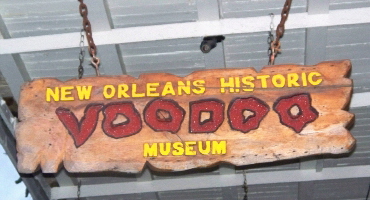 A sign for the New Orleans Historic Voodoo Museum, an attraction catering to tourist interest in Voodoo The civil rights movement of the 1950s and 1960s marked a new period in which the New Orleans tourist industry increasingly recognized African American culture as an integral aspect of the city's heritage.[151] From the 1960s onward, the city's tourist industry increasingly referenced Louisiana Voodoo as a means of attracting visitors.[152][153] In 1972, Charles Gandolfo established the tourist-oriented New Orleans Historic Voodoo Museum.[154] In New Orleans' French Quarter, as well as through mail-order catalogs and later the Internet, salespeople began selling paraphernalia that they claimed was associated with Voodoo.[152] Several companies also began providing walking tours of the city pointing out locations alleged to have a prominent role in the history of Voodoo, and in some cases staging Voodoo rituals for paying onlookers.[152] One company, Voodoo Authentica, began organizing an annual Voodoofest in Congo Square each Halloween, involving various stalls selling food and paraphernalia and a public Voodoo ceremony.[155] In the latter part of the 20th century, Voodoo saw a resurgence in New Orleans, a phenomenon reflecting some survivals from earlier practices, some imports from other African diasporic traditions, and some consciously revivalist approaches.[11] Various groups emerged; in 1990 the African American Miriam Chamani established the Voodoo Spiritual Temple in the French Quarter, which venerated deities from Haitian Vodou and Cuban Santería.[156] A Ukrainian-Jewish American initiate of Haitian Vodou, Sallie Ann Glassman, launched another group, La Source Ancienne, in the Bywater neighborhood; she also operated the Island of Salvation Botanica store.[157] The most publicly prominent of the new Voodoo practitioners was Ava Kay Jones, a Louisiana Creole woman who had been initiated into both Haitian Vodou and Orisha-Vodu, a U.S.-based derivative of Santería.[158] Long believed that these groups reflected a "Voodoo revival" rather than a direct continuation of 18th and 19th century traditions; she noted that this new Voodoo typically resembled Haitian Vodou or Santería more than the 19th-century Louisiana Voodoo.[11] These groups sought to promote understanding of their religion through websites, newsletters, and workshops.[11] |
20世紀と21世紀 20世紀初頭までに、ニューオリンズで活動する公的に著名なヴードゥー教修行者はいなくなった[147]。歴史家キャロリン・モロー・ロングによると、 「組織化された宗教としてのヴードゥー教は、法制度、世論、キリスト教によって徹底的に弾圧されていた」[147]。1930年代後半から1940年代初 頭にかけて、ヴードゥー教の歴史を記録する最初の本格的な試みが行われた。 [133]政府の労働進歩局の一環として、ルイジアナ作家プロジェクトは、1870年代から1890年代にかけて存在したヴードゥー教の経験について、 70人の高齢のニューオーリンズの黒人にインタビューするフィールドワーカーに資金を提供した。 [148]このインタビュー資料は、ジャーナリストであるロバート・タラントの『ニューオーリンズのヴードゥー教』(1946年に初版が出版され、セン セーショナルな報道を行ったが、今世紀を通じてこのテーマに関する卓越した著作とみなされるようになった[149])の部分的な基礎資料として使用され た。 神々や先祖を崇拝することに専念する共同体宗教としてのブードゥー教が衰退する一方で、出来事や人々を支配したり影響を与えたりすることを目的としたその 実践の多くは実践され続け、しばしばフードゥー教と呼ばれた[147]。ニューオーリンズでは、南部諸州の他の場所における同様のアフリカ系アメリカ人の 民間実践よりも、フードゥー教はローマ・カトリックの影響を大きく受けていた。 [147]フードゥーの専門家は「医者」または「労働者」として知られ、しばしば自宅や店舗でグリグリ、粉、油、香水、香を顧客に提供していた [147]。このような実践はアングロ・プロテスタントのエリートに懸念を抱かせ、市内での様々なヒーリングや占いの実践を制限する規制が導入され、その 結果、20世紀前半には多くのフードゥー実践者が有罪判決を受け、罰金または投獄された[150]。  ニューオーリンズ歴史ブードゥー博物館の看板。 1950年代と1960年代の公民権運動は、ニューオーリンズの観光産業がアフリカ系アメリカ人の文化を街の遺産の不可欠な側面として認識するようになっ た新たな時代を示した[151]。 1960年代以降、街の観光産業は観光客を惹きつける手段としてルイジアナ・ブードゥー教に言及するようになった[152][153]。 1972年、チャールズ・ガンドルフォは観光客向けのニューオーリンズ歴史ブードゥー教博物館を設立した[154]。 [154]ニューオーリンズのフレンチ・クオーターでは、通信販売のカタログや後にインターネットを通じて、ブードゥー教に関連すると主張する道具を販売 する販売員が現れ始めた[152]。 [152]ヴードゥー・オーセンティカ(Voodoo Authentica)という会社は、毎年ハロウィーンにコンゴ広場でヴードゥーフェストを開催するようになり、食べ物や道具を売る様々な屋台が出店し、 ヴードゥー教の儀式が公開された[155]。 20世紀後半、ヴードゥーはニューオーリンズで復活を遂げたが、この現象は以前の慣習からの生き残り、他のアフリカ系ディアスポラからの輸入、そして意識 的な復興主義的アプローチを反映したものであった[11]。1990年にはアフリカ系アメリカ人のミリアム・チャマニがフレンチ・クォーターにヴー ドゥー・スピリチュアル・テンプルを設立し、ハイチ・ヴォドゥーとキューバ・サンテリアの神々を崇めた。 [156]ウクライナ系ユダヤ人のハイチ・ヴォドゥの入信者であるサリー・アン・グラスマンは、バイウォーター地区で別のグループ、ラ・ソース・アンシエ ンヌを立ち上げた。 ロングは、これらのグループは18世紀と19世紀の伝統の直接的な継承というよりもむしろ「ヴードゥーの復興」を反映していると考えていた。彼女は、この 新しいヴードゥーは一般的に19世紀のルイジアナ・ヴードゥーよりもハイチン・ヴォドゥーやサンテリアに似ていると指摘した。 |
Demographics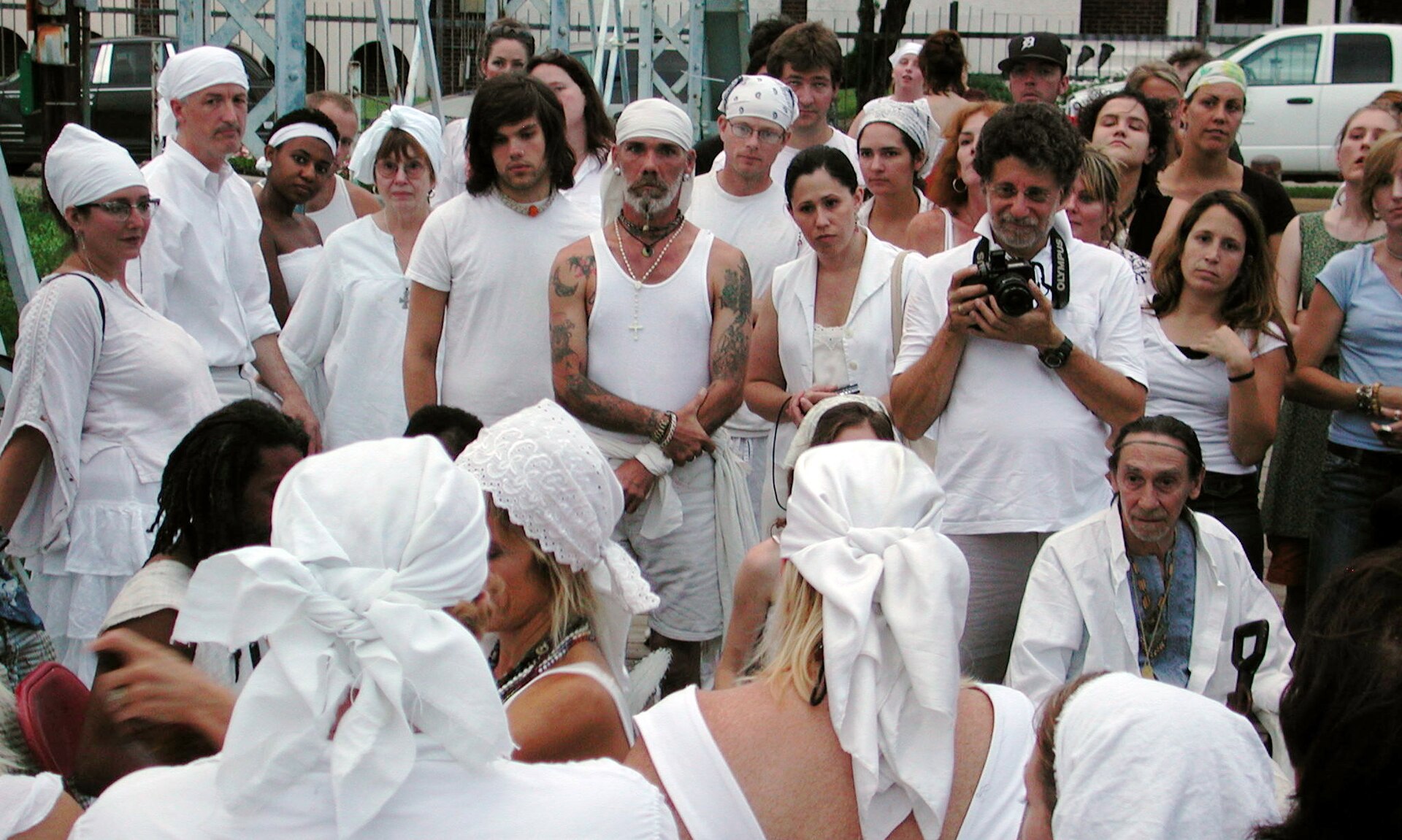 A group of Voodoo practitioners assembling at the Bayou St. John swing bridge on St John's Eve 2007 Some children are born into families that already practice Louisiana Voodoo; others come to the religion on their own.[30] In 1873, the Times Picayune estimated that there were about 300 dedicated practitioners of Voodoo in New Orleans, with about a thousand looser adherents.[138] In 2014, Newsweek reported a claim—cited to "locals"—that there had been between 2,500 and 3,000 practitioners in New Orleans at the start of the 21st century, but that following Hurricane Katrina and the subsequent dispersal of much of the city's population, that number was down to under 300.[159] 19th-century accounts suggest that white involvement was always a minority in Voodoo.[160] White people have been involved in Louisiana Voodoo since its early years;[21] oral accounts recorded in the 1930s and 1940s suggest that many of Marie Laveau's followers and clients had been white.[147] Tallant noted that, as of the 1940s, about a third of the religion's practitioners were white.[21] Tallant also thought that about 80 percent of practitioners were female.[161] Long noted that the "Voodoo revival" of the late 20th century had attracted many "well-educated" and middle-class Americans, both black and white.[11] Glassman's group has been described as having a white-majority membership.[75] In a 1995 article for The New York Times, Rick Bragg noted that many contemporary practitioners were "white people — nose and tongue piercers, middle-aged intellectuals and men with foot-long ponytails — who enjoy the religion's drumming and cultural aspects."[68] Osbey thought that this revival was appealing, especially to "young-ish whites", because they felt it offered "something at once forbidden, magical and compelling in its dramatic appeal"; in her view they were not real practitioners of Louisiana Voodoo because they do not descend from the ancestral spirits that the religion venerates.[162] |
人口統計 2007年のセントジョンズ・イブにバイユー・セントジョンのスイングブリッジに集まったヴードゥー教の修行者たち。 1873年、『タイムズ・ピカユーン』紙は、ニューオーリンズにはヴードゥーの熱心な信者が約300人、緩やかな信者が約1000人いると推定した [138]。 [138]2014年、『ニューズウィーク』誌は、21世紀初頭にはニューオーリンズには2,500人から3,000人の修行者がいたが、ハリケーン・カ トリーナとそれに続く市の人口の大半の散逸の後、その数は300人以下に減少したという「地元の人々」の主張を報じた[159]。 19世紀の証言によれば、白人の関与は常にヴードゥー教における少数派であった[160]。1930年代と1940年代に記録された口述によれば、マ リー・ルヴォーの信奉者と顧客の多くは白人であった[147]。タラントは、1940年代の時点で、この宗教の修行者の約3分の1は白人であったと述べて いる[21]。 ロングは、20世紀後半の「ヴードゥー教の復興」が、黒人と白人の両方を含む多くの「教養のある」中流階級のアメリカ人を惹きつけたと指摘した[11]。 グラスマンのグループは、白人が大多数を占めるメンバーを持っていると説明されている[75]。 1995年のニューヨーク・タイムズ紙の記事の中で、リック・ブラッグは、現代の多くの修練者が「白人-鼻や舌のピアスをしている人、中年の知識人、足の 長いポニーテールの男性-で、この宗教の太鼓や文化的な側面を楽しんでいる」と指摘した[68]。 「68]オズビーは、このリバイバルが特に「若者っぽい白人」にとって魅力的だったのは、彼らが「禁断的で呪術的で、劇的な魅力に説得力があるもの」を提 供していると感じたからだと考えた。 |
Reception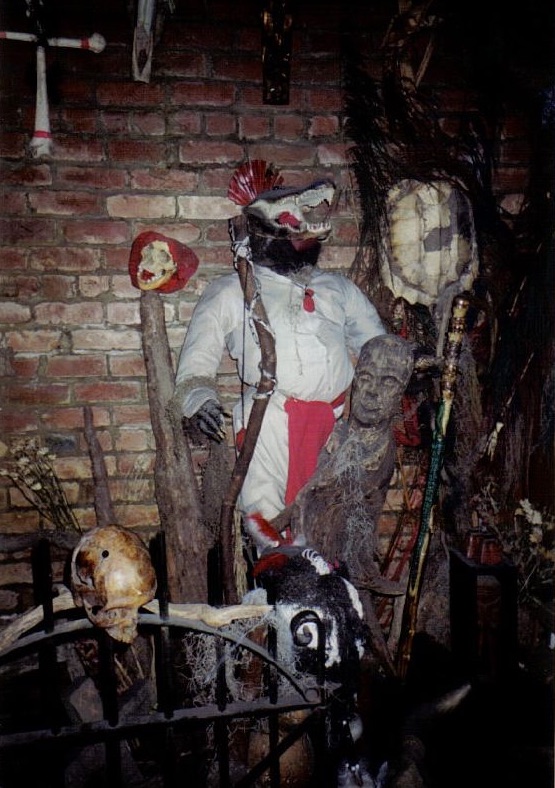 A display inside the Voodoo Museum at New Orleans' French Quarter, photographed in 1991 Like New Orleans itself, Louisiana Voodoo has long evoked both "fascination and disapproval" from the Anglo-dominated American mainstream.[163] Louisiana Voodoo has gained negative connotations in wider American society, being linked to witchcraft and hexing;[164] Protestant groups, including those present among the black New Orleanian population, have denounced Voodoo as devil worship.[147] During the 19th century, many Anglo-Protestant arrivals to New Orleans also considered Voodoo a threat to public safety and morality;[165] white writers in the late 19th century often expressed concern about the opportunities for miscegenation provided by Voodoo ceremonies, especially the presence of white women near to black men.[134] By the late 20th century, it was gaining increasing recognition as a legitimate religion of the African diaspora.[166] Sensationalist portrayals of Voodoo have been featured in a range of films and popular novels.[164] The 1987 film Angel Heart connected Louisiana Voodoo with Satanism;[152] the 2004 film The Skeleton Key evoked many older stereotypes although made greater reference to the actual practices of Louisiana Voodoo.[164] The 2009 Disney film The Princess and the Frog, which is set in New Orleans, depicted the character of Mama Odie as a practitioner of Vodou.[167] Characters practicing Louisiana Voodoo were also incorporated into the 2013 U.S. television series American Horror Story: Coven, where they were described as a coven of witches active since the 17th century.[168] Voodoo has also influenced popular music, as seen in songs like Jimi Hendrix's "Voodoo Chile" and Colin James' "Voodoo Thing".[169] The New Orleans singer Mac Rebennack took on the stage name of Dr. John after the 19th-century Voodoo practitioner and made heavy use of Voodoo terminology and aesthetics in his music; his first album, released in 1968, was titled Gris-Gris.[170] Elements of Voodoo were incorporated into the black Spiritual churches whose teachings drew upon Roman Catholicism, Spiritualism, and Pentecostalism.[147][171] |
レセプション ニューオーリンズのフレンチ・クォーターにあるブードゥー教博物館内の展示(1991年撮影) ニューオーリンズそのものと同様に、ルイジアナ・ブードゥーは長い間、アングロが支配するアメリカの主流派から「魅力と不支持」の両方を喚起してきた [163]。ルイジアナ・ブードゥーはより広いアメリカ社会で否定的な意味合いを持つようになり、魔術や呪術と結びつけられてきた[164]。ニューオー リンズの黒人を含むプロテスタントのグループは、ブードゥーを悪魔崇拝として非難してきた。 [147]19世紀には、ニューオーリンズに到着した多くのアングロ・プロテスタントもヴードゥーを治安と道徳に対する脅威とみなしていた[165]。 19世紀後半の白人作家はしばしば、ヴードゥーの儀式によってもたらされる混血の機会、特に黒人男性の近くに白人女性がいることについて懸念を表明してい た[134]。20世紀後半になると、アフリカン・ディアスポラの正当な宗教として認知が高まっていた[166]。 1987年の映画『エンジェル・ハート』はルイジアナ・ブードゥーを悪魔崇拝と結びつけた[152]。2004年の映画『スケルトン・キー』は、ルイジア ナ・ブードゥーの実際の慣習により大きく言及したものの、多くの古いステレオタイプを呼び起こした。 [164] ニューオーリンズを舞台とした2009年のディズニー映画『プリンセスとカエル』では、ママ・オーディのキャラクターがヴォドゥーの実践者として描かれて いる[167] ルイジアナ・ヴードゥーを実践するキャラクターは、2013年のアメリカのテレビシリーズ『アメリカン・ホラー・ストーリー』にも登場した: コヴェン』では、17世紀から活動している魔女の集会として描かれていた[168]。 ブードゥー教はポピュラー音楽にも影響を与えており、ジミ・ヘンドリックスの「Voodoo Chile」やコリン・ジェームズの「Voodoo Thing」のような曲に見られる[169]。ニューオーリンズのシンガー、マック・レベナックは19世紀のブードゥー教の修行者にちなんでドクター・ ジョンという芸名を名乗り、ブードゥー教の用語や美学を音楽に多用した。1968年にリリースされた彼のファーストアルバムのタイトルは「Gris- Gris」であった[170]。 ヴードゥーの要素は、ローマ・カトリック、スピリチュアリズム、ペンテコステ派の教えを取り入れた黒人スピリチュアル教会に取り入れられた[147] [171]。 |
| Sources Alvarado, Denise (2020). The Magic of Marie Laveau: Embracing the Spiritual egacy of the Voodoo Queen of New Orleans. Newsburyport, MA.: Weiser Books. p. xi, 46. ISBN 978-1-57863-673-0. Anderson, Jeffrey (2008). Hoodoo, Voodoo, and Conjure: A Handbook. Westport, CT: Greenwood Press. ISBN 978-0313342219. Anderson, Jeffrey E. (2024). Voodoo: An African American Religion. Baton Rouge: Louisiana State University Press. ISBN 978-0-8071-8132-4. Anderson, Stacey (August 25, 2014). "Voodoo Is Rebounding in New Orleans After Hurricane Katrina". Newsweek. Retrieved May 2, 2021. Armitage, Natalie (2015). "European and African Figural Ritual Magic: The Beginnings of the Voodoo Doll Myth". In Ceri Houlbrook; Natalie Armitage (eds.). The Materiality of Magic: An Artifactual Investigation into Ritual Practices and Popular Beliefs. Oxford: Oxbow. pp. 85–101. ISBN 978-1785700101. Bragg, Rick (August 18, 1995). "New Orleans Conjures Old Spirits Against Modern Woes". The New York Times. Retrieved May 8, 2021. Crockett, I'Nasah (2018). "Twentieth-Century Voodoo: Black Culture, Cultural Geographies, and the Meaning of Place". In Dennis Waskul; Marc Eaton (eds.). The Supernatural in Society, Culture, and History. Philadelphia: Philadelphia University Press. pp. 152–170. ISBN 978-1439915257. Fandrich, Ina J. (2007). "Yorùbá Influences on Haitian Vodou and New Orleans Voodoo". Journal of Black Studies. 37 (5): 775–791. doi:10.1177/0021934705280410. JSTOR 40034365. S2CID 144192532. Ferguson, Josh-Wade (2016). ""Traded it off for that Voodoo Thing": Cultural Capital and Vernacular Debt in Disney's Representation of New Orleans". The Journal of Popular Culture. 49 (6): 1224–1240. doi:10.1111/jpcu.12486. Green, Tara T. (2012). "Voodoo Feminism through the Lens of Jewell Parker Rhodes's Voodoo Dreams" (PDF). Women's Studies. 41 (3): 282–302. doi:10.1080/00497878.2012.655135. S2CID 144748485. Gordon, Michelle (2012). ""Midnight Scenes and Orgies": Public Narratives of Voodoo in New Orleans and Nineteenth-Century Discourses of White Supremacy". American Quarterly. 64 (4): 767–786. doi:10.1353/aq.2012.0060. JSTOR 4231284. S2CID 143787706. LeBlanc, Amanda Kay (2018). ""There's Nothing I Hate More than a Racist:" (Re)centering Whiteness in American Horror Story: Coven". Critical Studies in Media Communication. 35 (3): 273–285. doi:10.1080/15295036.2017.1416418. S2CID 148841474. Long, Carolyn Morrow (2002). "Perceptions of New Orleans Voodoo: Sin, Fraud, Entertainment, and Religion". Nova Religio: The Journal of Alternative and Emergent Religions. 6 (1): 86–101. doi:10.1525/nr.2002.6.1.86. JSTOR 10.1525/nr.2002.6.1.86. O'Neill Schmitt, Rory; Hartel O'Neill, Rosary (2019). New Orleans Voodoo: A Cultural History. Charleston, SC: The History Press. ISBN 978-1467137997. Osbey, Brenda Marie (2011). "Why We Can't Talk to You about Voodoo". The Southern Literary Journal. 43 (2): 1–11. doi:10.1353/slj.2011.0001. S2CID 159807747. Reuber, Alexandra (August 2011). "Voodoo Dolls, Charms, And Spells In The Classroom: Teaching, Screening, And Deconstructing The Misrepresentation Of The African Religion". Contemporary Issues in Education Research. 4 (8). Tallant, Robert (1983) [1946]. Voodoo in New Orleans. Macmillan. Touchstone, Blake (1972). "Voodoo in New Orleans". Louisiana History: The Journal of the Louisiana Historical Association. 13 (4): 371–386. JSTOR 4231284. |
情報源 Alvarado, Denise (2020). マリー・ルボーの呪術: ニューオーリンズのヴードゥーの女王のスピリチュアルなエガシーを受け入れる。マサチューセッツ州ニューズベリーポート。ISBN 978-1-57863-673-0. Anderson, Jeffrey (2008). Hoodoo, Voodoo, and Conjure: A Handbook. Westport, CT: Greenwood Press. ISBN 978-0313342219. Anderson, Jeffrey E. (2024). Voodoo: アフリカ系アメリカ人の宗教。Baton Rouge: Louisiana State University Press. ISBN 978-0-8071-8132-4. Anderson, Stacey (August 25, 2014). 「Voodoo Is Rebounding in New Orleans After Hurricane Katrina」. Newsweek. 2021年5月2日取得。 Armitage, Natalie (2015). 「European and African Figural Ritual Magic: The Beginnings of the Voodoo Doll Myth」. In Ceri Houlbrook; Natalie Armitage (eds.). The Materiality of Magic: An Artifactual Investigation into Ritual Practices and Popular Beliefs. オックスフォード: オックスフォード:Oxbow. ISBN 978-1785700101. Bragg, Rick (August 18, 1995). 「New Orleans Conjures Old Spirits Against Modern Woes」. The New York Times. Retrieved May 8, 2021. Crockett, I'Nasah (2018). 「Twentieth-Century Voodoo: Black Culture, Cultural Geographies, and the Meaning of Place」. Dennis Waskul; Marc Eaton (eds.). The Supernatural in Society, Culture, and History. Philadelphia: Philadelphia University Press. ISBN 978-1439915257. Fandrich, Ina J. (2007). 「Yorùbá Influences on Haitian Vodou and New Orleans Voodoo」. Journal of Black Studies. 37 (5): 775–791. doi:10.1177/0021934705280410. jstor 40034365. s2cid 144192532. Ferguson, Josh-Wade (2016). 「「Traded it off for that Voodoo Thing」: ディズニーのニューオーリンズ表象における文化資本とヴァナキュラー・デット」. The Journal of Popular Culture. 49 (6): 1224–1240. doi:10.1111/jpcu.12486. Green, Tara T. (2012). 「ジュエル・パーカー・ローズの『ヴードゥー・ドリームス』のレンズを通して見たヴードゥー・フェミニズム" (PDF). Women's Studies. 41 (3): 282–302. doi:10.1080/00497878.2012.655135. s2cid 144748485. Gordon, Michelle (2012). 「Midnight Scenes and Orgies": ニューオリンズにおけるヴードゥー教の公的物語と19世紀の白人至上主義の言説」. American Quarterly. 64 (4): 767–786. doi:10.1353/aq.2012.0060. JSTOR 4231284. S2CID 143787706. LeBlanc, Amanda Kay (2018). 「「There's Nothing I Hate More than a Racist:」 (Re)centering Whiteness in American Horror Story: Coven」. Critical Studies in Media Communication. 35 (3): 273–285. doi:10.1080/15295036.2017.1416418. s2cid 148841474. Long, Carolyn Morrow (2002). 「Perceptions of New Orleans Voodoo: Sin, Fraud, Entertainment, and Religion」. Nova Religio: The Journal of Alternative and Emergent Religions. 6 (1): 86–101. doi:10.1525/nr.2002.6.1.86. JSTOR 10.1525/nr.2002.6.1.86. O'Neill Schmitt, Rory; Hartel O'Neill, Rosary (2019). ニューオーリンズ・ブードゥー: A Cultural History. Charleston, SC: The History Press. ISBN 978-1467137997. Osbey, Brenda Marie (2011). 「Why We Can't Talk to You about Voodoo」. The Southern Literary Journal. 43 (2): 1–11. doi:10.1353/slj.2011.0001. s2cid 159807747. Reuber, Alexandra (August 2011). 「Voodoo Dolls, Charms, And Spells In The Classroom: 授業におけるブードゥー人形、お守り、おまじない:アフリカの宗教の誤認を教え、審査し、解体する」. 教育研究の現代的課題。4 (8). Tallant, Robert (1983) [1946]. Voodoo in New Orleans. Macmillan. Touchstone, Blake (1972). 「Voodoo in New Orleans」. Louisiana History: The Journal of the Louisiana Historical Association. 13 (4): 371-386. JSTOR 4231284. |
| https://en.wikipedia.org/wiki/Louisiana_Voodoo |
Junior Wells Hoodoman Blues.(中河 2021:198)
Tami
Lynn - Mojo Hannah
Hoodoo
Hoodoo (Remastered 2003)
Somebody
Done Hoodooed the Hoodoo Man" by Louis Jordan
リ ンク
文 献
そ の他の情報
Copyleft,
CC, Mitzub'ixi Quq Chi'j, 1996-2099